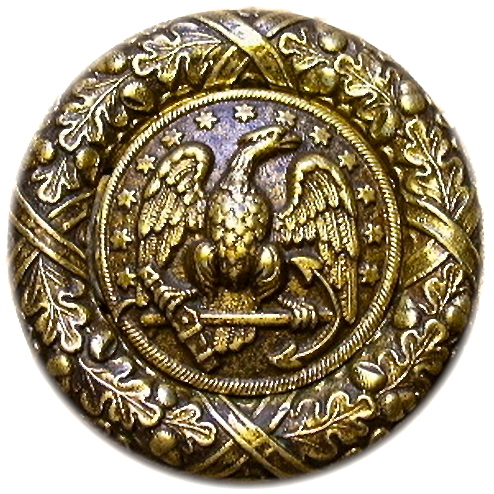18th & 19th Century United States Navy
Regulation Issue Buttons

United States Navy
1798-1810 13 Five Point Stars
By the early 1800’s, America’s small Navy was sailing the around the world trying to desperately protect it’s arboriculture, agriculture, and material exports. Commodities such as, agriculture and durable dry goods where often seen as easy targets for shipping predators of African Muslim states. The Barbary Coast of Africa had a history of kidnapping the crews of US merchant vessels, as well as other nations ships for ransoms. As bribery scheme to stop these high seas crimes, these barbaric muslim pirates demanded an annual lump sum ransom and often times extorted countries to pay them in advance not to do it. This was plain extortion, and stupidly other European nations paid the small ransom requests then sending out their Navies. For them it was cheaper and easier then paying for a military campaign. This muslim form of extortion could be viewed like the old NYC mobs insurance policies of protection offered to small business merchants. The Continental Congress agreed to the extortion, and the administrations of Presidents George Washington, John Adams, and Thomas Jefferson unwillingly followed suite in paying these Muslim extortionists right from the onset of our federal governments founding in 1789.
Even though later Presidents such as, John Adams and Thomas Jefferson were continually vocally opposed to giving in to the demands of the terrorists, they sought out preventive measures but with seafaring aggressions it was hard for America’s small navies to be active combatants for commercial merchants. John Adams continually being frustrated had come up with the idea to sell America’s Navy ships to the commercial market. This would relieve Congress out of the responsibility of paying the extortionists. Unfortunately, with the problem would still remain for American financiers of commercial exports. Thomas Jefferson took the opposite approach and strengthened our navy and changed it’s policies of engagement to a more proactive stance. Jefferson wasn’t intimidated by the pirate fleets and decided the challenge required a strong military response in the face of these uncivilized muslim barbarians who tried to extort nations within freely navigable waters.
So, the First Barbary War is America’s first confrontation with these filthy bedouin Islamic religious fanatical pirates. Historical research into these pirates indicate they would commit unprovoked terroristic acts on anyone all because of their 5th century barbaric teachings of their Quran. According to Robert Davis in “Christian Slaves, Muslim Masters,” from 1530 to 1780, over a million Europeans were captured and sold as slaves by the Muslim Barbary powers. Morocco was an independent sultanate, while Tunis, Algiers, and Tripoli (Libya) were semiautonomous provinces of the Ottoman Empire. Most European nations found it cheaper to pay the Muslim barbaric terrorists ransoms or extortion fees rather than call for an outright war.
By the early 19th century, the standard navy Officer’s Copper Repousse (shell) buttons with bone or wood backs were slowly being replaced with more contemporary durable brass one-piece buttons. America’s new eagle and anchor insignias would be proudly displayed by Naval Officers. These new brass flat or slightly domed one-piece buttons were durable and long-lasting compared to their previous counterparts. They were even more detailed by artisans who had liberty of design within regulation of design. The old impressed design was now being replaced with raised insignia and lettering. This new style button was used up until the early 1830’s, and then gave way to an even stronger 2-piece construction. This new raised one-piece flat button had a short lived evolution which quickly gave way into 2-piece construction. This enabled the button to give artisans the ability to have intricate details due to the nature of technological manufacturing innovations which could tool precise details within the motifs. It even enabled the insignias to be set off high or low convex fields which in-turn enriched the dynamics of the pattern’s design. Meaning, it allowed for greater details.
This new two-piece button construction prevailed throughout the manufacturing industry in every country, and carried onward right into the 20th century. Just to note, there were some early pioneering by Birmingham English and French manufacturers in two-piece Navy buttons in the late 1820’s, but it wasn’t until the 1830’s to the 1850’s when the new method of construction was widely adapted. As you will see in the Navy button collection below, there were several different American, British, and French manufacturers who produced their own distinct style for their country’s regulation requirements for the Navy, but could be interchanged and used all. Buttons collectors should also note that most design patterns were short lived due to various reasons. Sort of like car companies coming out with updated models every year. Even though patterns are very similar, there were a lot of button producers offering their own versions sticking to the patterns of the country’s naval regulations. The fun for button collectors will be finding similar patterns that have slight differences in the eagle, the crown, flukes, cable, or how many points and numbers of stars are portrayed.
Robert’s Notes: The term, “Fouled Anchor” is the current state the anchor is in when describing it. The term was originally used by seamen to advise that the anchor is caught-up or hooked on some impediment on the ocean floor. In our Navy button’s case it is the description of the cable, rope, or chain being wrapped around the stock, shaft, and crown.
1792 U.S. Navy button in the close of George Washington’s 1st Admin.
Dug in La Rochelle, in France 2017


1792-97 United States Navy Button
Close of George Washington’s 1st Administration
Color: Ochre of Yellow, Brown, & Red W/ Gilt Remnants.
Metal: Flat, 1-Piece, Impressed Design, Gilt Brass.
Size: 23mm. Coat Size
Albert’s Number: NA 32-B RV 25 but must be error : RV 250, for I never see these ever offered.
Variation: Eagle Facing Left / Standing on Feather / A Barbed Crown / 15 Eight-Pointed Stars.
Present Condition: An Excavated Specimen, A Good Planchet Condition Remains, A Strong Impression Remains.
Isabela’s Notes: Albert list’s two variants, but below I believe is a third. NA 31 & 32 are early impressed devices, but the Eagle in NA 31 faces right, as NA 32’s variants face left. NA 31 also depicts 13 six pointed stars. NA 32’s variants the Eagle rests on a single Feather instead of the usual mound found on all Navy buttons. The difference between NA 32 A & B appears to be the number of stars, and how many points on each star. This button depicts the Eagle Facing Left while standing on a Feather. The device depicts 15 eight pointed stars.There is a large oval shield over it’s right wing. Within is a Large Thick Raised Anchor set on an evenly lined field. There is a relaxed rope coming off the anchor’s top ring on the right hand-side. The rope wraps under the Anchor’s stock diagonally, and then curled in a short fish hook facing left. As a decorative border, there is an inside Unique Rope Border that encompasses the large anchor and linked field. Encircling the eagle is 15 Eight-Pointed Stars that circle around the button’s edge. The impressed pattern is set on a plain flat field without a raised edge design guard.
Reverse Button Analysis: This is a flat one-piece button with a loop shank. The shank is original, but crushed inward. No backmark.
The RJ. Silverstein Collection.~

1792-97 United States Navy Button
Close of George Washington’s 1st Administration
Color: A Golden-Brown with Green Undertones.
Metal: Flat, 1-Piece, Impressed Design, Cast Gilt Brass.
Size: 23mm.
Albert’s Number: Similar to NA 32 Series Unlisted Variant – : RV 50
Variation: Large Thick Raised Anchor / Unique Rope Border/ 16 Five-Pointed Stars.
Present Condition: An Excavated Example, Good Planchet Condition, Strong Impressed Pattern Remains.
Isabela’s Notes: This Navy button would be very similar to Albert’s NA 32 series, but minor differences in the number of stars and eagle’s pattern. Albert NA 32 gives examples of 14 & 15 stars, but none 16. So a specimen might not have been available, or dug during his time. The button’s pattern depicts an old style eagle standing with a “Goose Neck” facing left. There is a large oval shield over it’s right wing. Within is a Large Thick Raised Anchor set on a lined field. There is a relaxed rope coming off the anchor’s top ring on the right hand-side. The rope wraps under the Anchor’s stock diagonally, and then under the lower shaft and right fluke and ends in a short fish hook below. As a decorative border, there is an inside Unique Rope Border that encompasses the large anchor. Encircling the eagle is 16 Five-Pointed Stars that go around the button’s edge. The impressed pattern is set on a plain flat field with no edge.
Reverse Button Analysis: This is a flat one-piece button with a loop shank. The shank is original, straight, and intact. No back mark.


1798-1802 United States Navy Button
Issued under the John Adams Administration
Color: Dusty Brown With Black Pattern Highlights.
Metal: 1-Piece, Slightly Convex, Raised Design, Pewter.
Size: 25mm. Coat Size
Albert’s Number: Unlisted Variant – Similar to NA 8.1: RV 35-50
Variation: Slanted Oval Shield/ 15 Five-Pointed Stars
Present Condition: An Excavated Example, Fair Planchet Condition, A Fair High Relief Pattern Remains.
Isabela’s Notes: This Navy button would be very similar to Albert’s NA 8, but has minor differences in the Anchor/Rope design. We know that by 1802, the Navy prescribed a radical change in the uniforms, and added two more stars, making it a 15 star arrangement. So that gives us the earliest date the button could have been used (previously ordered buttons only had 13 stars encircling the eagle). The button’s pattern depicts a standing Eagle Facing Left, with a Slanted Oval Shield covering over it’s right wing. There is a small raised anchor design depicted on a plain field. There is a dangling rope coming off the anchor’s top ring on the right hand-side. The rope wraps under the Anchor’s stock, and then over and under the shaft, and then ends in a fish hook below the anchor’s crown. Encircling the eagle is 15 Five-Pointed Stars around the button’s edge. The whole pattern is in high relief on a plain slightly convex field with no edge border.
Reverse Button Analysis: This is a flat one-piece button with a loop shank. The shank is original, straight, and intact. No backmark.


1798 to 1810 United States Navy Button
Issued under the John Adams & Thomas Jefferson Administrations
Color: An Ochre of Golds Browns, Yellows, & Burgundies.
Metal: 1-Piece, Raised Design, Gilt Brass.
Size: 23.2 mm. Coat Size
Albert’s Number: NA 6-A: RV 35-50
Variation: Large Vertical Oval Shield / Large Thin Fouled Anchor / Lined Field / Stock is Straight / Crown is Barbed /13 Five-Pointed Stars
Present Condition: An Non Excavated Specimen, Exceptional Planchet Condition, An Exceptional High Relief Pattern Remians.
Isabela’s Notes: There are five known die variants for this pattern in the coat size, and one for the cuff size. All depict 13 five-pointed stars, but vary in the depiction of the eagle, anchor, and shield. This button’s pattern depicts a standing eagle with up-raised wings facing left. There is a Large Vertical Oval Shield that has a Large Thin Fouled Anchor on a Lined Field. The anchor’s Stock is Straight and the Crown is Barbed. The cable comes off the anchor’s top ring on the left hand-side. The cable goes under the stock, and then loops over the shaft 2x, and then goes over the left fluke and ends in a fish hook below the crown. Circling around the eagle on the button’s edge is 13 Five-Pointed Stars. The high relief pattern is set on a plain flat field.
Reverse Button Analysis: This is a flat one-piece button with a loop shank. The shank is original, straight, and intact. CARIN & C / TREBLE GILT rm.
The Robert J. Silverstein Collection.~


1798 to 1810 United States Navy Button
Issued under the John Adams & Thomas Jefferson Administrations
Color: Tarnished Brown Brass.
Metal: Flat, 1-Piece, Raised Design, Gilt Brass.
Size: 20.18mm. Cuff Size
Albert’s Number: NA 6-B: RV 50
Variation: Large Oval Vertical Shield / Shield’s Evenly Lined Field / Barbed Crown / 13 Five-Pointed Stars.
Present Condition: An Excavated Specimen, Strong Planchet Condition, Good High Relief Pattern Remains.
Isabela’s Notes: There are two known die variant for this pattern. The button’s pattern depicts an Eagle with Upraised Wings standing on a mound Facing Left. Covering over the eagle’s right wing is a Large Oval Vertical Shield with a raised outline. Depicted on the Shield’s Evenly Lined Field is a Medium Size Fouled Anchor with a Straight Stock and a Slightly Barbed Crown. There is a cable coming off the anchor’s Small Upright Top Ring on the left hand-side. The cable wraps under the anchor’s stock, and then goes under the shaft 2x, the left fluke, and then wraps under the crown in a fish hook. Circling around the eagle is 13 Five-Pointed Stars. The high relief pattern is set on a plain flat field. Collector’s note at least four variations to the NA 6 series with some unlisted sub-variations (as shown in the button below).
Reverse Button Analysis: This is a flat one-piece button with a loop shank. The shank is original, straight, and intact. H & T / Gilt.
The RJ. Silverstein Collection.~
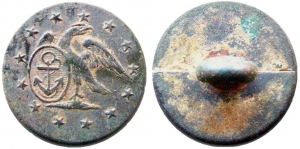
1798 to 1810 United States Navy Button
Issued under the John Adams & Thomas Jefferson Administrations
Color: Rusty Brown With Hints of Green
Metal: Flat, 1-Piece, Raised Design, Brass.
Size: 15mm. Cuff Size
Albert’s Number: NA 6-Bv: Unlisted Size Variant RV 35-50
Variation: Small Oval Vertical Shield / Shield’s Lined Field / Straight Stock / Barbed Crown / Large Top Ring / 13 Five-Pointed Stars.
Present Condition: An Excavated Example, Strong Planchet Condition, Strong High Relief Pattern Remains.
Isabela’s Notes: This is the second known die variant for this pattern. The button’s pattern depicts an eagle with upraised wings standing on a mound facing left. Covering over the eagle’s right wing is a Small Oval Vertical Shield with a raised outline. Depicted on the Shield’s Lined Fieldis a Small Fouled Anchor with a Straight Stock and a slightly Barbed Crown. There is a cable coming off the anchor’s Large Top Ring on the left hand-side. The cable wraps under the anchor’s stock, and then goes under the shaft 2x, and then wraps under the crown in a fish hook. Circling around the eagle is 13 Five-Pointed Stars. The high relief pattern is set on a plain flat field with no raised edge border. Collector’s note at least four variations to the NA 6 series.
Reverse Button Analysis: This is a flat one-piece button with a loop shank. The shank is original, straight, and intact. No back mark, mold line present.


1798 to 1810 United States Navy Button
Issued under the John Adams & Thomas Jefferson Administrations
Color: Rusty Orange.
Metal: 1-Piece, Raised Design, Gilt Brass.
Size: 22mm. Coat Size
Albert’s Number: NA 6-C: RV 35-50
Variation: Small Oval Vertical Shield / Shield’s Lined Field / Straight Thick Stock / Larger V-Shaped Crown / Large Top Ring / 13 Five-Pointed Stars
Present Condition: An Excavated Example, Strong Planchet Condition, A Strong High Relief Pattern Remains.
Isabela’s Notes: This early Navy button was made by English manufacturers for Naval Officers. This would be the third known die variant for this pattern. In this variation the anchor is depicted with a V-Shape Crown and the stock is slightly thicker. The button’s pattern depicts an eagle with upraised wings standing on a mound while facing left. Covering over the eagle’s right wing is a Small Oval Vertical Shield. Depicted on the Shield’s Lined Field is a fouled anchor with a Straight Thick Stock and a Larger V-Shaped Crown. There is a cable coming off the anchor’s top ring on the left hand-side. The cable wraps under the anchor’s stock, and then goes under the shaft 2x, and then wraps under the crown in a fish hook. Circling around the eagle is 13 Five-Pointed Stars. The high relief pattern is set on a plain flat field with no raised edge border.
Reverse Button Analysis: This is a flat one-piece button with a loop shank. The boss is still present, but the shank is missing. TREBLE *GILT*
The Pete T. Collection, New York.

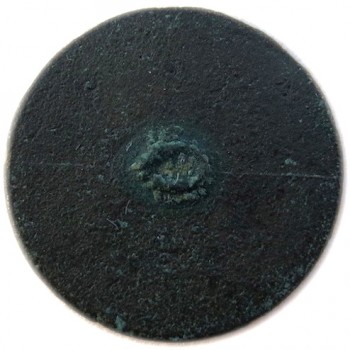
1798 to 1810 United States Navy Button
Issued under the John Adams & Thomas Jefferson Administrations
Color: Coppery Brown with Green Encrustations.
Metal: 1-Piece, Raised Design, Gilt Brass.
Size: 19.39mm. Coat Size
Albert’s Number: NA 6-D: RV 50
Variation: Large Oval Shield/ Anchor’s Slanted Stock /13 Five-Pointed Stars
Present Condition: An Excavated Specimen, Good Planchet Condition, A Good High Relief Pattern Remains.
Isabela’s Notes: This is the fourth known pattern for this button. Early Naval button collectors who specialize usually favor this variant because it is the only one that depicts a slanted stock. Also, this is the only button in the series in which the rope doesn’t loop around the shaft twice. The button’s pattern depicts an eagle with upraised wings standing on a mound while facing left. Covering over the eagle’s right wing is a Vertical Oval Shield. Depicted on the Shield’s Lined Field is a fouled anchor with a Slanted Stock and a Rounded Crown. There is a cable coming off the anchor’s top ring on the left hand-side. The cable goes over the anchor’s stock, then under the shaft once, then goes over right fluke, and then ends touching the shield’s edge below the crown. Circling around the eagle is 13 Five-Pointed Stars. The high relief pattern is set on a plain flat field with no raised edge border. Un-dug specimens are un-herd of, and dug specimens are rarely offered.
Reverse Button Analysis: This is a flat one-piece button with a loop shank. The shank is crushed inward, and decayed.
The RJ Silverstein Collection.~

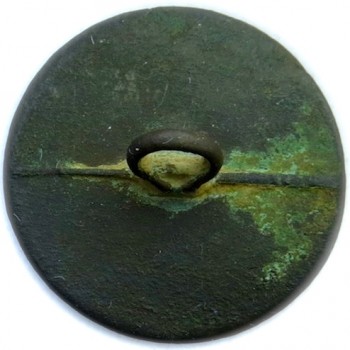
1798 to 1810 United States Navy Button
Issued under the John Adams & Thomas Jefferson Administrations
Color: Seaweed Green.
Metal: Flat, 1-Piece, Raised Design, Brass.
Size: 24.31mm. Coat Size
Albert’s Number: NA 7-A.1: RV 50
Variation: Large Slanted Oval Shield / Thin Fouled Anchor / Anchor’s Slanted Stock / Thin Shaft /Slightly Barbed Crown / 13 Six-Point Stars
Present Condition: An Excavated Specimen, Good Planchet Condition, A Good High Relief Pattern Remains.
Isabela’s Notes: This is another rare collector’s favorite for early American Navy buttons that depicts 13 stars. This Pattern was made by Wishart in New York. Buttons could either have a blank back mark, or show Wishart N. York rm. The button’s pattern depicts an eagle standing on a mound facing left. Covering over the eagle’s right wing is a Large Slanted Oval Shield. Depicted on the shield is a Large Thin Fouled Anchor with a Slightly Barbed Crown that is set on a lined field. There is a cable coming off the anchor’s top ring on the left hand-side. The cable wraps under the Anchor’s Slanted Stock, then over and under a Thin Shaft, and then hangs under the left fluke. Circling around the eagle is 13 Six-Point Stars. The high relief pattern is set on a plain flat field with no raised edge border. Collector’s should obtain any specimen that becomes available. Un dug examples and specimens with shanks are extremely rare.
Reverse Button Analysis: This is a flat one-piece button with a loop shank. The shank is original, straight, and intact. No back mark, mold line present.
The RJ Silverstein Collection.~
1 of 3 Dug by Muddy Spider on Saint Simons Island, Georgia in 2009.
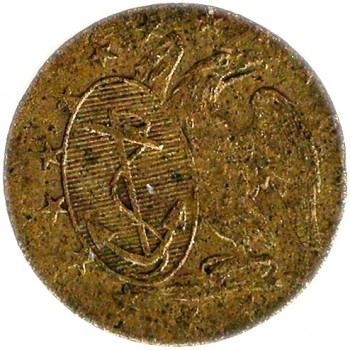
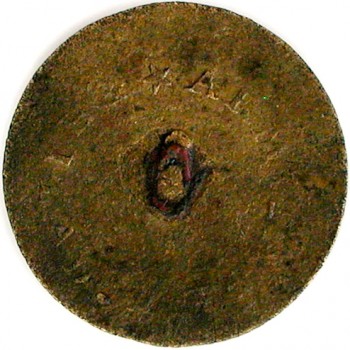
1802 to 1810 United States Navy Button
Issued under Thomas Jefferson Administration
Color: Dark Brown.
Metal: 1-Piece, Raised Design, Brass.
Size: 17.5mm. Coat Size
Albert’s Number: NA 9 RV 40
Variation: Large Oval Shield / Large Raised Anchor Slanted Stock / 16 Six-Pointed Stars
Present Condition: An Excavated Specimen, Strong Planchet Condition, An Exceptional High Relief Pattern Remains.
Isabela’s Notes: There appears to be at least three button makers that produced this pattern for the navy. This button was most likely used before, during, and after the War of 1812. The button’s pattern depicts a standing Eagle facing left, with a Large Oval Shield covering over it’s right wing. There is a Large Raised Anchor motif with a Slanted Down Stock on an evenly lined field. There is a dangling rope coming off the anchor’s top shaft on the left hand-side. The rope wraps around the anchor’s stock repeatedly, and then ends in a fish hook below the anchor’s crown. Encircling the eagle is 16 Six-Pointed Stars around the button’s edge. Even thought this pattern probably wasn’t manufactured anymore after 1810, it still was most likely used until a new replacement uniform was ordered with the newer style buttons.
Reverse Button Analysis: This is a flat one-piece button with a loop shank. The shank is original, and intact, but bent inwards. George Armitage backmark.
The Pete T. Collection, New York.

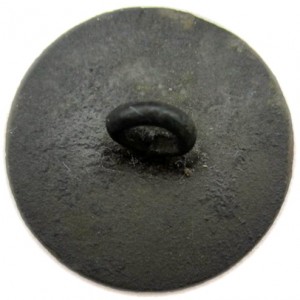
1802 to 1810 United States Navy Button
Issued under Thomas Jefferson Administration
Color: Dark Brown.
Metal: 1-Piece, Raised Design, Brass.
Size: 19.93mm. Coat Size
Albert’s Number: NA 9 RV 40
Variation: Large Oval Shield / Large Raised Anchor Slanted Stock / 16 Six-Pointed Stars
Present Condition: An Excavated Specimen, Strong Planchet Condition, An Exceptional High Relief Pattern Remains.
Isabela’s Notes: This is one of the earliest known Eagle patterns issued to the Navy. This was most likely used before, during, and after the War of 1812. The button’s pattern depicts a Standing Eagle facing left, with a Large Oval Shield covering over it’s right wing. There is a Large Raised Anchor motif with a Slanted Down Stock on a lined field. There is a dangling rope coming off the anchor’s top shaft on the left hand-side. The rope wraps around the anchor’s stock repeatedly, and then ends in a fish hook below the anchor’s crown. Encircling the eagle is 16 Six-Pointed Stars around the button’s edge.
Reverse Button Analysis: This is a flat one-piece button with a loop shank. The shank is original, straight, and intact. No backmark.
Excavated by J.B. in sandy soil at Fernadina, Beach Florida.
The RJ Silverstein Collection.

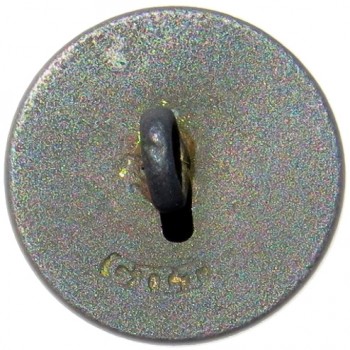
1802-1808 South Carolina Navy
Color: A Chocolate Brown With Gold Pattern Highlights.
Metal: Flat, 1-Piece, Raised Design, Gilt Brass.
Size: 22.45mm. Coat Size
Albert’s: NA 10-B (Page 491) Isabela’s RV 200
Variation: Two Headed Spread Eagle / Upright Fouled Anchor / Semi Circle of 15 Six-Pointed Asterisk Type Stars
Present Condition: An Excavated Specimen, Strong Planchet Condition, A Strong Impression Remains.
Robert’s Comments: We know in the early years that South Carolina formed their own Navy to patrol the Charleston Harbor. This particular die variant with the two headed eagle could have been produced as early as the first variant (the pattern with the single headed eagle Albert’s NA 10-A’s) in 1802. The button’s pattern depicts a Two Headed Spread-Eagle above an Upright Fouled Anchor. On the eagle’s chest is a small federal type shield. In the eagle’s left talon is a small bundle of Three Arrows Pointing Upwards. In the right talon is a Small Laurel or Olive Branch. The anchor’s top ring has a rope or chain coming off the left hand-side, and then goes under a slanted stock, and then over and under the shaft, and then hangs over the right fluke. Surrounding the eagle’s is a Semi Circle of 15 Six-Pointed Asterisk Type Stars. Since this is a gilt brass button, I would resume it was intended for officers. I also don’t believe they were produced in any large quantities, most likely a very limited issue for a small Navy. To my knowledge, this is probably the Best Specimen known to exist. There is also a matching cuff button, but Ultra Rare with only 6 or 7 known to exist.
Reverse Button Analysis: This is flat one-piece button with a loop shank. The shank is original, straight, and intact.
The RJ Silverstein Collection.
Dug Near Charleston, South Carolina.

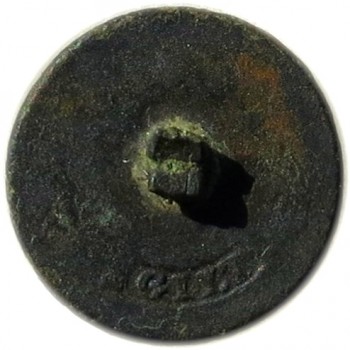
1802 – 1808 South Carolina Navy
Color: Deep Brown with Orange & Green Speckles.
Metal: Flat, 1-Piece, Raised Design, Gilt Brass.
Size: 14.56mm. Cuff Size
Albert’s: NA 10-Bv (Page 491) Unlisted Size Variant Isabela’s RV 250
Variation: Two Headed Spread Eagle / Upright Fouled Anchor / Semi Circle of 15 Six-Pointed Asterisk Type Stars
Present Condition: An Excavated Specimen, Good/Strong Planchet Condition, A Good Impression Remains.
Robert’s Comments: We know in the early years that South Carolina formed their own Navy to patrol the Charleston Harbor. This particular die variant with the two headed eagle could have been produced as early as the first 1802; the same time frame as the pattern with the single headed eagle (Albert’s NA 10-A’s). The button’s pattern depicts a Two Headed Spread-Eagle above an Upright Fouled Anchor. On the eagle’s chest is a small federal type shield. In the eagle’s left talon is a small bundle of Three Arrows Pointing Upwards. In the right talon is a Small Laurel or Olive Branch. The anchor’s top ring has a rope or chain coming off the left hand-side, and then goes under a slanted stock, and then over and under the shaft, and then hangs over the right fluke. Surrounding the eagle’s is a Semi Circle of 15 Six-Pointed Asterisk Type Stars. Since this is a gilt brass button, my belief is that it was intended for officers. I also believe these would have been made in half the quantity of the coat issue, most likely a very limited issue. This cuff is Ultra Rare and I believe only 4 or 5 known specimens exist. Collectors should seek any specimen available. These cuff specimens should probably be in a Charleston, S.C. museum for prosperity.
Reverse Button Analysis: This is flat one-piece button with a loop shank. The shank is unfortunately missing.
The RJ Silverstein Collection.
Dug Near Charleston, South Carolina.
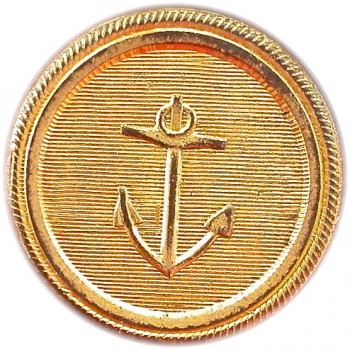

1787 1790’s US NAVY OFFICERS PATTERN / BRITISH DESIGN
Color: A White Wash Gold.
Metal: Flat, 1-Piece, Raised Design, Gilt Brass.
Size: 20mm.
Albert’s: NA 16
Variation: High Relief Anchor / Cable Border / Slightly Angled Stock / Relaxed Top Ring
Present Condition: An Excavated Specimen, Strong Planchet Condition, A Strong High Relief Pattern Remains.
Robert’s Comments: This was probably one of the first new British designs for Royal Navy officers when they changed there motif regulation over from an impressed anchor to a high-relief anchor in 1787. From the strike over reverse, this was most likely older stock of un-used military buttons. Albert also believed it was used by U.S. Navy officers after the Revolutionary War. The button’s pattern depicts a Large Anchor with a Slightly Angled Stock and a Relaxed Top Ring. The Crown is slightly barbed with Two Dissimilar Flukes. The fluke on the right appears to have a line reaching through the end. Not sure of a design significance to that. The anchor is set on an evenly lined field within a Port Hole Frame that has a Cable Border circling around the outside.
Reverse Button Analysis: This is a one-pice buttons with a loop shank. Strike over EXTRA QUALITY Channel of 16 Stars. 3 channel markers.
The Pete T. Collection.
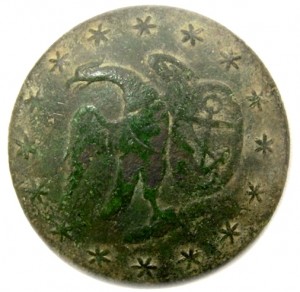
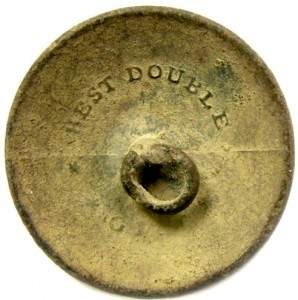
1810 to 1830 United States Navy Button
Issued under James Madison’s Administration
Color: Seaweed Green with Dusty Brown.
Metal: Slightly Convex, 1-Piece, Raised Design, Gilt Brass.
Size: 24.7mm. Coat Size
Albert’s Number: NA 36-A: RV 50
Variation: Federal Shield on Breast/ 16 Six-Pointed Asterisk Type Stars
Present Condition: An Excavated Specimen, Good Planchet Condition, A Good High Relief Pattern Remains.
Isabela’s Notes: This is an interesting series in which the eagle has a patriotic federal shield on it’s breast. Most likely an English manufactured button. The button’s pattern depicts a standing eagle facing right, with a Federal Shield on it’s Breast. There is another Large Oval Shield that is Slanted under the eagle’s left wing. On the shield there is a raised anchor motif on a lined field. There is a rope coming off the anchor’s top ring on the right hand-side, and goes under the stock, over the shaft, and then under the left fluke, and ends in a fish hook under the crown. There are 16 Six Pointed Asterisk Type Stars encircling the periphery. The high relief button is set on a plain slightly convex field with no distinguishable edge.
Reverse Button Analysis: This is a one-piece button with a loop shank. The shank is original and intact, but bent over. BEST DOUBLE *GILT*
Picture Courteous of Harry Ridgeway.
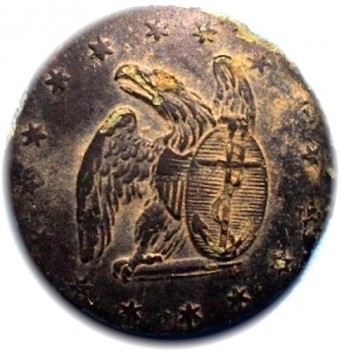
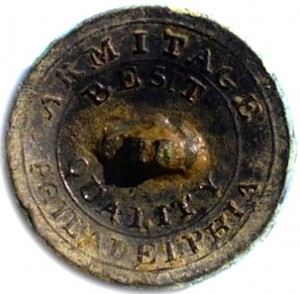
1810 to 1820’s United States Navy Button
Issued under James Madison and James Monroe’s Administrations.
Color: Brown with Spots of Orange Oxidation.
Metal: 1-Piece, Slightly Convex Brass.
Size: 21mm. Coat Size
Variation: 16 Six-Pointed Stars / Elongated Oval Shield
Albert’s Number: NA 38: RV 40
Present Condition: An Excavated Example, Good Planchet Condition, A Strong High Relief Remains.
Isabela’s Notes: This Navy button’s pattern depicts a standing eagle facing right, with a Federal Shield on it’s Breast. There is another Elongated Oval Shield under the eagle’s left wing with a large raised anchor pattern on a lined field. There is a rope or chain coming off the top ring of the anchor on the left hand side. Encompassing the eagle is 16 Raised Six-Pointed Stars encircling the periphery. George Armitage produced these buttons in the early 1800’s. The high relief button is set on a plain slightly convex field with no distinguishable edge. The Best Quality back mark on the reverse dates around 1810.
Reverse Button Analysis: This is a one-piece button with a loop shank. The original shank is broken off. ARMITAGE PHILADELPHIA/BEST QUALITY 2 rings
Excavated in Burlington County, NJ. by Neil Schwartz
Neil Schwärt Collection.


1798 to 1812 United States Navy Button
Issued under T. Jefferson & James Madison Administrations.
Color: Charcoal With Green & Brown Encrustations.
Metal: 1-Piece, Slightly Convex, Raised Design, Gilt Brass.
Size: 23mm. Coat Size
Albert’s Number: NA 41 RV 15
Variation: Small Slanted Oval Shape Shield / Plain Anchor / 13 Five-Pointed Stars
Present Condition: An Excavated Specimen, Strong Planchet Condition, A Strong High Relief Pattern Remains.
Isabela’s Notes: This is another variation of an early US Navy pattern. The button’s pattern depicts a standing eagle with upraised wings facing right. In this die variant there is a Small Slanted Oval Shape Shield, with the depiction of a Plain Anchor on a lined field. Encompassing the eagle is 13 Five-Pointed Stars around the button’s edge. The high relief button is set on a plain slightly convex field with no distinguishable edge.
Reverse Button Analysis: This is a slightly concave one-piece button with a loop shank. The shank is original, straight, and intact. THREE FEATHERS /WREATH / S rm.
The RJ. Silverstein Collection.~
Dug By J.Baldwin in Pensacola Florida in the 1980’s.
Robert, you have an early Navy Button on your website (shown below) dated 1810-1830, has a wreath Prince of wales Feather and the raised letter “S”.
That is the maker’s mark of Mark Sanders Esq., of Birmingham a relatively little know but Eminent Button-Maker of Birmingham, he was a religious non-conformist so little favorable was written in the press or histories of Birmingham. He is the man who first implemented the Mercury recovery system that helped workers in the button industry avoid the effects of the mercury vapor. I have traced his manufacturing history and he used this mark 1798-1812. So this is one of the last buttons that came in before trade completely ceased due to the War of 1812 (or alternatively, it was made prior to 1812, warehoused and exported in 1816 when trade reopened) . He was one of the merchants engaged in the American shipping trade. I traced his history for the Eagle Button section I am working on he exported at least 3 different eagle types I have seen, two types before the War of 1812 and one after. He uses the Prince of Wales feathers on several of his other plain gilt buttons of the same period, as well as the Crown and wreath type. – Bob Milburn.
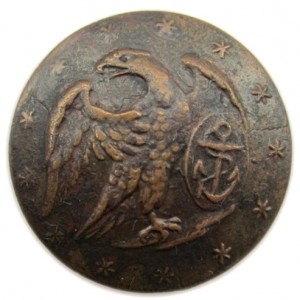

1810 to 1830’s United States Navy Button
Issued under James Madison and James Monroe’s Administrations.
Color: Light Two Tone Brown.
Metal: Slightly Convex, 1-Piece, Raised Design, Gilt Brass.
Size: 22.94mm. Coat Size
Albert’s Number: NA 44-A: RV 15
Variation: Small Slanted Raised Shield/ 13 Six-Pointed Asterisk Type Stars / Outstretched Wing.
Present Condition: An Excavated Specimen, Strong Planchet Condition, A Strong High Relief Pattern Remains.
Isabela’s Notes: This style Navy button could have been manufactured as early as 1810, but the back mark on this particular specimen dates to the early 1820’s. Lewis & Tomes was an English maker who operated a partnership in America from 1819 through the 1830’s. There are three manufacturer die variants for this particular pattern. This variant depicts a standing eagle facing right, with a Small Slanted Raised Shield under it’s Outstretched Wing. There is a small raised foul anchor depicted on the shield’s stippled field. There is a rope coming off the right hand-side of the anchor’s top ring, which goes under the stock, then over and under the shaft, and ends below the anchor’s crown on the right hand side. Encompassing the eagle, there are 13 Six-Pointed Asterisk Type Stars that circle around the button’s edge. The high relief button is set on a plain slightly convex field with no distinguishable edge. Un-dug specimens for this pattern are extremely rare, collectors should seek dug ones with a clear image of the breast feathers.
Reverse Button Analysis: This is a one-piece button with a loop shank. The original shank is original, straight, and intact. No L & T FINE GILT in 2 dm ring.
The RJ Silverstein Collection.
Dug by J. Baldwin near Fort Conde, Mobile Alabama.
Robert’s Notes: Edward Lewis was an English manufacturer isn London. He previously was partnered with Francis Tomes in New York City in 1819. Tomes went on and operated under several names and made a variety of military goods throughout the Civil War.
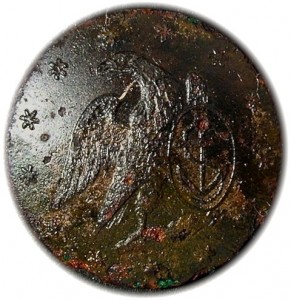

1810 to 1830’s United States Navy Button
Issued under James Madison and James Monroe’s Administrations.
Color: A Dark Brownish With Heavy Green Undertones.
Metal: Slightly Convex, 1-Piece, Raised Design, Gilt Brass.
Size: 22.4mm. Coat Size
Albert’s Number: NA 44-C: RV 15
Variation: Vertical Shield / Close to the Body / 13 Six-Pointed Asterisk Type Stars
Present Condition: An Excavated Example, Strong Planchet Condition, A Strong High Relief Pattern Remains.
Isabela’s Notes: This is another die variant from an English manufacturer that was in business from 1818-25. This button’s pattern depicts a standing eagle facing right that has a more Vertical Oval Shield over it’s left wing. In this die variant, the eagle’s left wing is small and Close to the Body. There is a raised foul anchor motif on the shield’s stippled field. In this variant, the dangling rope comes of the anchor’s top ring on the right side, and then goes under the stock, then over the shaft, then under the fluke and ends in a fish hook tail halfway under the anchor’s crown. Encompassing the eagle, there is 13 Six-Pointed Asterisk Type Stars circling around the edge’s periphery. The high relief pattern is set on a plain slightly convex field with no distinguishable edge. Un-dug specimens are extremely rare, collectors should seek dug ones with a good portion of the breast feathers retained.
Reverse Button Analysis: This is a one-piece button with a loop shank. The original shank is original and intact, but slightly bent over. WISE BIELBY & Co No 4 *EXTRA FINE *
The Harry Ridgeway Collection.~
Dug in Boonsboro, Maryland.
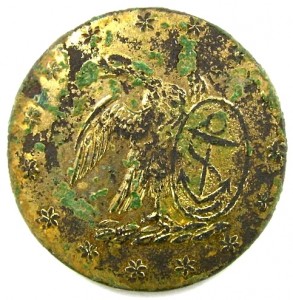

1802 to 1830’s United States Navy Button
Issued under Thomas Jefferson, James Madison, and James Monroe’s Administrations.
Color: A Golden Brown With Green Encrustations.
Metal: Slightly Convex, 1-Piece, Raised Design, Gilt Brass.
Size: 23.6mm. Coat Size
Albert’s Number: NA 52 RV 50
Variation: Large Stippled Shield / Large Raised Anchor Motif / 15 Six-Point Asterisk Type Stars.
Present Condition: An Excavated Example, Strong Planchet Condition, Good, A Strong High Relief Pattern Remains.
Isabela’s Notes: This gilded brass Navy button was intended for officers, and produced by an English manufacturer. This is an unlisted die variant for Albert’s NA 54, but could as well be a variant for NA 57. The button’s pattern depicts a standing eagle facing right, with a Large Slightly Slanted Oval Shield under it’s left wing. Within the shield, there is a Large Raised Anchor Motif set on a stippled field. In this variant, the dangling rope comes of the anchor’s top ring on the right side, and then goes under the stock, then over the shaft, then under the fluke, and ends in a fish hook tail halfway under the anchor’s crown. Encompassing the eagle, there are 15 Six-Point Asterisk Type Stars encircling the eagle around the button’s edge. This high relief pattern is set on a plain convex field. The back mark indicates 1820’s manufacture (Treble 52).
Reverse Button Analysis: The is a one-piece button with a loop shank. The shank is original and intact, but slightly bent. TREBLE GILT. ORANGE within a 2 rm ribbons.
Old Court House Museum.~
Dug in Shepherdstown, Virginia by Brian Irving.
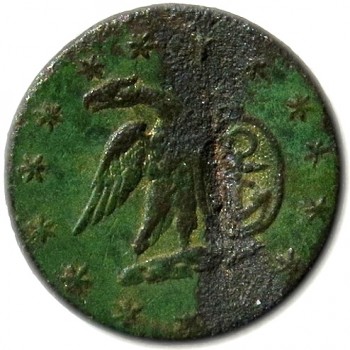

1802 to 1812 United States Navy Button
Issued under James Madison and James Monroe’s Administrations.
Color: A Florescent Seaweed Green.
Metal: Flat 1-Piece, Slightly Convex, Raised Design, Gilt Brass.
Size: 15.75mm. Cuff Size ~ Flat!
Albert’s Number: Similar to NA 52-Unlisted Size Variant RV 100
Variation: Small Shield / Small Raised Anchor Motif / 15 Six-Point Asterisk Type Stars.
Present Condition: An Excavated Example, Good Planchet Condition, A Good High Relief Pattern Remains.
Isabela’s Notes: This is an unlisted size variant in Albert’s book. The pattern and star count match Albert’s NA 52 examples, but this specimen is “Flat”. Since this cuff button was produced in a Gilt finish, this was most likely intended for officers. The asterisk type stars points to English manufactures of the time. The button’s pattern depicts a Standing Eagle Facing Right, with a Small Slightly Slanted Oval Shield over it’s left wing. Within the shield, there is a Small Raised Anchor Motif on a plain field. In this variant, the rope comes of the anchor’s top ring on the right side, and then goes under the stock, and then over the shaft, and then under the left fluke. The rope and ends in a fish hook under the anchor’s crown. Circling around the eagle is 15 Six-Point Asterisk Type Stars. This high relief pattern is set on a slightly convex plain field.
Reverse Button Analysis: The is a one-piece button with a loop shank. The shank is original, straight, and intact.
The RJ Silverstein Collection.
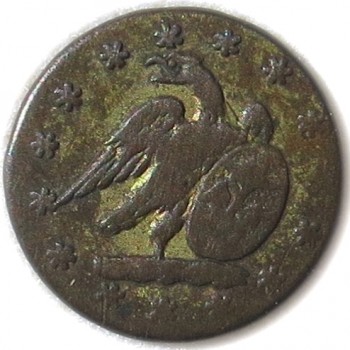
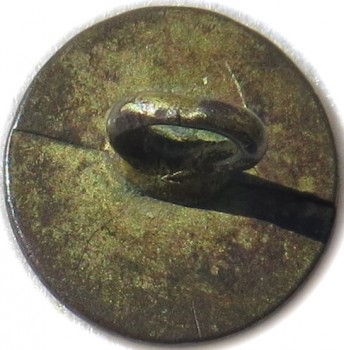
1802 to 1812 United States Navy Button
Issued under Thomas Jefferson & James Madison Administrations.
Color: A Florescent Seaweed Green.
Metal: Flat 1-Piece, Slightly Convex, Raised Design, Gilt Brass.
Size: 12.25mm. Cuff Size
Albert’s Number:NA 53-Unlisted Cuff Size Variant RV ?
Variation: Stippled Shield / Small Raised Anchor Motif / 15 Six-Point Asterisk Type Stars.
Present Condition: A Non Excavated Specimen, Strong Planchet Condition, Strong High Relief Pattern Remains.
Robert’s Notes: In Albert’s book NA 53’s Motif. This is the cuff for the 20mm. Cuff button was produced in a Gilt finish, so most likely intended for officers. The button’s pattern depicts a Standing Eagle Facing Right, with a Slightly Slanted Oval Stippled Shield over it’s left wing. Within the shield, there is a Small Raised Anchor Motif on a Stipple field. In this variant, the rope comes of the anchor’s top ring on the right side, and then goes under the stock, and then over the shaft, and then under the left fluke. The rope and ends in a fish hook under the anchor’s crown. Circling around the eagle is 15 Six-Point Asterisk Type Stars. This high relief pattern is set on a slightly convex plain field.
Reverse Button Analysis: The is a one-piece button with a loop shank. The shank is original, straight, and intact.
The RJ Silverstein Collection.
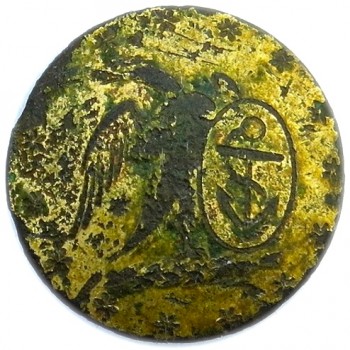
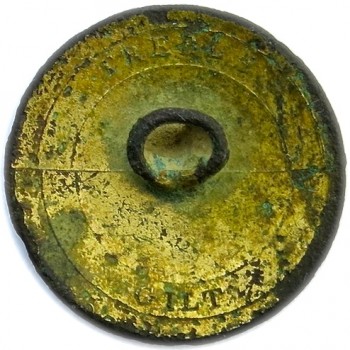
1810 to 1830 United States Navy Button
Issued under James Madison and James Monroe’s Administrations.
Color: A Golden Brown
Metal: 1-Piece, Slightly Convex, Raised Design, Gilt Brass.
Size: 23.6mm. Coat Size
Albert’s Number: NA 52-Unlisted Back Mark Variant RV 50
Variation: Large Stippled Shield / Large Raised Anchor Motif / 15 Six-Point Asterisk Type Stars.
Present Condition: An Excavated Example, Good Planchet Condition, A Good High Relief Pattern Remains.
Isabela’s Notes: This is another die variant for NA 52 that shows a slightly more thicker fluke and crown. This most likely was intended for officers since it has a Gilt finish, and is also produced by an English manufacturer. The button’s pattern depicts a standing Eagle Facing Right, with a Large Slightly Slanted Oval Shield over it’s left wing. Within the shield, there is a Large Raised Anchor Motif that is set on a stippled field. In this variant, the rope comes of the anchor’s top ring on the right side, and then goes under the stock, and then over the shaft, and then under the left fluke. The rope and ends in a fish hook halfway under the anchor’s crown. Circling around the eagle is 15 Six-Point Asterisk Type Stars. This high relief pattern is set on a slightly convex plain field. The back mark indicates 1820’s manufacture.
Reverse Button Analysis: The is a one-piece button with a loop shank. The shank is original and intact, but bent over. TREBLE GILT in a 2 ring rm channel.
The RJ. Silverstein Collection.
2 of 3 Dug by Muddy Spider on Saint Simons Island, Georgia in late 2009.
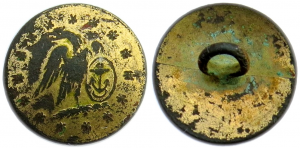
1810 to 1830 United States Navy Button
Issued under James Madison and James Monroe’s Administrations.
Color: A Pale Yellow Brown
Metal: 1-Piece, Slightly Convex, Raised Design, Gilt Brass.
Size: 14.84mm. Cuff Size
Albert’s Number: Similar to NA 52-Unlisted Size Variant RV 75
Variation: Small Shield / Small Raised Anchor Motif / 15 Six-Point Asterisk Type Stars.
Present Condition: An Excavated Example, Good Planchet Condition, A Good High Relief Pattern Remains.
Isabela’s Notes: This is an unlisted size variant in Albert’s book. The pattern and star count match Albert’s NA slightly convex example. This cuff button was most likely intended for officers. The asterisk type stars points to English manufacture, but not 100% certain. The button’s pattern depicts a standing eagle facing right, with a Small Slightly Slanted Oval Shield over it’s left wing. Within the shield, there is a Small Raised Anchor Motif on a plain field. In this variant, the rope comes of the anchor’s top ring on the right side, and then goes under the stock, and then over the shaft, and then under the left fluke. The rope and ends in a fish hook under the anchor’s crown. Circling around the eagle is 15 Six-Point Asterisk Type Stars. This high relief pattern is set on a slightly convex plain field.
Reverse Button Analysis: The is a one-piece button with a loop shank. The shank is original, straight, and intact. No back mark.
The RJ. Silverstein Collection.
3 of 3 Dug by Muddy Spider on Saint Simons Island, Georgia in late 2009.
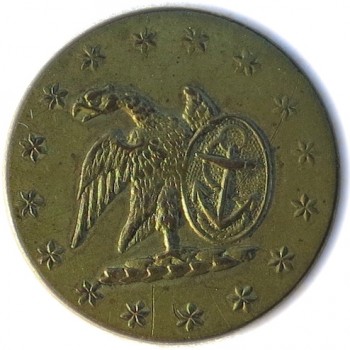
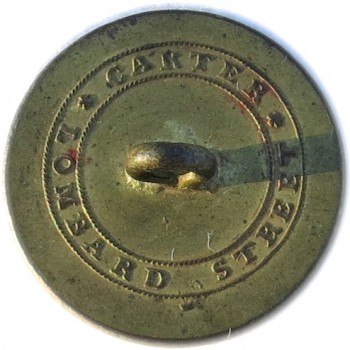
1802 to 1820’s United States Navy Button
Issued under Thomas Jefferson & James Madison Administrations.
Color: Original Brass.
Metal: Flat, 1-Piece, Raised Design, Gilt Brass.
Size: 22.06mm. Coat Size
Variation: Slightly Slanted Oval Shield / 16 Asterisk Type Six-Pointed Stars.
Albert’s Number: NA 54-A: RV 25
Present Condition: A Non Excavated Specimen, Exceptional Planchet Condition, An Exceptional High Relief Pattern Remains.
Isabela’s Notes: This early Navy button was made by several manufacturers in England and the United States. The button’s pattern depicts a standing Goose Neck Eagle Facing Right, with a Slightly Slanted Oval Shield covering over it’s left wing. There is a large fouled anchor motif on the shield that is set on a stippled field. There is a rope coming off the anchor’s top ring on the right hand-side. The rope wraps under the anchor’s stock, shaft and fluke, and then dangles in a long fishhook below the slightly barbed crown. Encircling the eagle is 16 Raised Six-Point Asterisk Type Stars. The high relief pattern is set on a plain flat field. Albert notes that this button was originally produced in 1802, and the pattern was most likely was used for 25 years.
Reverse Button Analysis: This is a flat one-piece button with a loop shank. The shank is original, straight, and intact. rm CARTER * /LOMARD STREET * set in the middle of a rm double rope channel.
The RJ. Silverstein collection.


1802 to 1812 United States Navy Button
Issued under Thomas Jefferson & James Madison Administrations.
Color: A Charcoal Silver.
Metal: Slightly Convex, 1-Piece, Raised Design, Silvered Copper.
Size: 23mm. Coat Size
Variation: Slightly Slanted Oval Shield / 16 Asterisk Type Six-Pointed Stars.
Albert’s Number: NA 54-A: RV 25
Present Condition: An Excavated Example, Good Planchet Condition, A Good High Relief Pattern Remains.
Isabela’s Notes: This early Navy button was made by several manufacturers in England and the US. The button’s pattern depicts a standing Goose Neck Eagle facing right, with a Slightly Slanted Oval Shield under it’s left wing. There is a large fouled anchor motif on the shield that is set on a stippled field. There is a rope coming off the anchor’s top ring on the right hand-side. This wraps under the anchor’s stock, shaft and fluke, and then dangles in a long fishhook underneath the crown. Encircling the eagle is 16 Raised Six-Point Asterisk Type Stars around the periphery. The high relief pattern is set on a plain flat field. Albert notes this button was produced in 1802, and most likely was used for 25 years.
Reverse Button Analysis: This is a flat one-piece button with a loop shank. The shank is original, straight, and intact. rm CARTER * /LOMARD STREET * set in the middle of a rm double rope channel.
Dug in Connecticut in the 1990’s.
The Dale Collection.~


1811 to 1820’s United States Navy Button
Issued under James Madison and James Monroes Administrations.
Color: A Golden Brown.
Metal: 1-Piece, Slightly Convex, Raised Design, Gilt Brass.
Size: 23.27mm. Coat Size
Albert’s Number: NA 57-A RV 20
Variation: Right Profile Eagle / Large Slanted Oval Shield / Short Straight Stock / Round Crown / Stipple Cable.
Present Condition: A Non Excavated Example, Exceptional Planchet Condition, An Exceptional High Relief Pattern Remains.
Isabela’s Notes: There are quite a few die variants known for this specific pattern that depicts 16 stars. Levenworth, Hayden and Scovill, actually produced this button between 1811 and 1820. The pattern differences are in the eagle’s feathers, neck length & shape, anchor size, and the cable design. This button’s pattern depicts a right hand side profile of an Eagle Looking Skyward while standing on a cable. Under the eagle’s left wing is a Large Slanted Oval Shield that has a raised outline edge. Depicted on the shield is a Medium Size Fouled Anchor with a Short Straight Stock, and a Round Crown. Coming off the anchor’s top ring on the left hand-side is a raised Stipple Cable. The cable goes over the stock, and then under the shaft and left fluke, and hangs in a fish hook facing left below the crown. Circling around the button’s edge is 16 Six-Pointed Stars. The high relief pattern is set on a plain slightly-convex field. Un-dug specimens are rarer.
Reverse Button Analysis: This is a slightly concave one-piece button with a loop shank. The shank is original, straight, and intact. L. H & S.W.Ct. * Treble Gilt.
The RJ Silverstein Collection.


1810 to 1820’S United States Navy Button
Issued under James Madison, James Monroe, & Quincy Adams Administrations.
Color: A Gilded Charcoal.
Metal: Slightly Convex, 1-Piece, Raised Design, Gilt Brass.
Size: 24.5mm. Coat Size
Albert’s Number: Similar to NA 57-A: Unlisted Backmark Variant RV 25
Variation: Large Slanted Oval Shield / Small Foul Anchor / 16 Six-Pointed Asterisk Type Stars
Present Condition: An Excavated Example, Strong Planchet Condition, A Strong High Relief Pattern Remains.
Isabela’s Notes: This is an English manufacturers variation for (NA 57-A) a Navy Officer’s 16 Star Pattern. This button’s pattern depicts an Eagle Looking More Skyward while standing on a cable. Under the eagle’s left wing is a Large Slanted Oval Shield that has a raised outline. Depicted on the shield is a Medium Size Fouled Anchor with a Short Straight Stock, and a Round Crown. Coming off the anchor’s top ring on the left hand-side is a raised Stipple Cable. The cable goes over the stock, and then under the shaft and left fluke, and hangs in a fish hook racing left below the crown. Circling around the button’s edge is 16 Six-Pointed Stars. The high relief pattern is set on a plain slightly-convex field.
Reverse Button Analysis: The is a one-piece button with a loop shank. The shank is original and intact, but slightly bent. TREBLE GILT. ******* within a rm channel.
The RJ. Silverstein Collection.
Dug in Cold Harbor, Virginia 2007.


1810 to 1830’s United States Navy Button
Issued under James Madison, James Monroe, & Quincy Adams Administrations.
Color: Brass Yellow.
Metal: 1-Piece, Slightly Convex, Raised Design, Gilt Brass.
Size: 23.31mm. Coat Size
Albert’s Number: NA 57-B RV 25
Variation: Eagle Facing Right / Large Slanted Oval Shield / Medium Size Fouled Anchor / Barbed Crown / 16 Six Point Asterisk Type Stars.
Present Condition: A Non Excavated Specimen, Exceptional Planchet Condition, An Exceptional High Relief Pattern Remains.
Isabela’s Notes: Since there were several companies making these buttons, a collector can find more then one die variant for this specific pattern: NA 57. The main differences are in the eagle’s feathers, neck size & length, and the style of the cable depicted. This die variant has an intricate design in the feather detail. This button’s pattern depicts an Eagle Facing Right while standing on a mound. Collectors should note three distinct inside tail feathers, along with a fuller looking right wing. Under the eagle’s left wing is a Large Slanted Oval Shield with a raised outline. Depicted on the shield is a Medium Size Fouled Anchor with a Slightly Slanted Stock, and a Barbed Crown. Coming off the anchor’s top ring on the right hand-side is a lined or dash style cable. The rope goes over the stock, and then under the shaft and left fluke, and then hangs in a fish hook racing right below the crown. Circling around the button’s edge is 16 Six-Pointed Asterisk Type Stars. The high relief pattern is set on a plain slightly convex field. Dug specimens are available with some frequency.
Reverse Button Analysis: This is a slightly concave one-piece button with a loop shank. The shank is original, straight, and intact. TREBLE GILT within a Ribbon rm / ORANGE within a Ribbon rm.
The RJ Silverstein Collection.
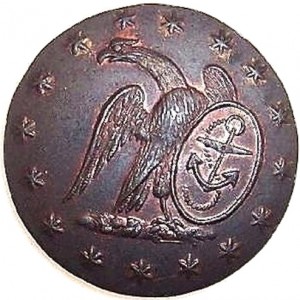
1811 to 1820’s US Navy Button
Color: Brass Yellow.
Metal: 1-Piece, Slightly Convex, Raised Design, Gilt Brass.
Size: 23mm. Coat Size
Albert’s Number: NA 57-B RV 15
Variation: Goose Neck Eagle / Three Inside Tail Feathers / Large Slanted Oval Shield / Small Fouled Anchor / 16 Six Pointed Stars.
Present Condition: An Excavated Example, Strong Planchet Condition, A Strong High Relief Pattern Remains.
Isabela’s Notes: This is another die variant for NA 57 B 16 Star pattern. This pattern shows a different feather pattern then the earlier specimen. This button’s pattern depicts a Goose Neck Eagle standing on a cable looking to the right. This die variant shows three distinct tail feathers and lean slim wings. Covering over the eagle’s left wing is a Large Slanted Oval Shield that depicts a Small Fouled Anchor. The anchor’s stock is slightly slanted and the crown is barbed. There is a rope that comes off the anchor’s top ring on the right hand-side. The rope goes over the stock and then under the shaft and left fluke, and hangs in a fish hook racing right below the crown. Circling around the button’s edge is 16 Six-Pointed Stars. The high relief pattern is set on a plain convex field.
Reverse Button Analysis: This is a slightly concave one-piece button with a loop shank. The shank is original, straight, and intact. TREBLE GILT / ORANGE rm.
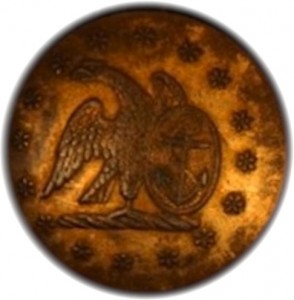

1811-20’s US Navy Button
Color: A Patchy Golden Brown.
Metal: 1-Piece, Convex, Raised Design, Gilt Brass.
Size: 23mm. Coat Size
Variation: Eagle Standing on a Cable / Slightly Slanted Oval Shield / Large Fouled Anchor / 16 Raised Six-Point Flower Type Stars.
Albert’s Number: NA 57-D: Albert PG 491 RV 25
Present Condition: A Non Excavated Example, Strong Planchet Condition, A Strong High Relief Remains.
Isabela’s Notes: This is another die variant in the series. This pattern depicts a slightly different style eagle. The button’s pattern depicts an Eagle Standing on a Cable looking to the right. Under the eagle’s left wing is a very Slightly Slanted Oval Shield. Depicted on the shield is a Large Fouled Anchor on a stippled field. The stock of the anchor is straight and the crown is slightly barbed. There is a rope coming off the anchors top ring on the right hand-side. This goes under the stock, and then twists under the shaft, and left fluke. The cable then ends in a long fishhook passing under the crown and going all the way up to the right fluke. Circling around the outside edge is 16 Raised Six-Point Flower Type Stars. The high relief pattern is set on a plain convex field. Collectors should note this is the most scarce pattern out of the NA 57 16 star series.
Reverse Button Analysis: This is a one-piece button with a loop shank. The shank is original, straight, and intact. A M Peasley Boston rm.

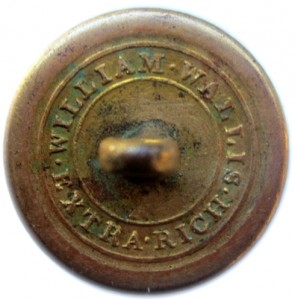
1820’s United States Navy Officer’s Button
Color: A Tinted Yellow Brass.
Metal: Flat,1-Piece, Raised Design, Gilt Brass.
Size: 22.83mm. Coat Size
Variation: Small Slanted Spade Shaped Shield / Lined Field / Small Raised Anchor / Straight Stock / V-Shape Crown /13 Six-Pointed Stars.
Albert’s Number: NA 62-E: RV 20
Present Condition: A Non Excavated Specimen, Exceptional Planchet Condition, An Exceptional High Relief Remains.
Isabela’s Notes: This button was originally intended for Naval Officers. The button’s pattern depicts a standing eagle facing right, with up-raised wings. Partially covering over the eagle’s left wing is a Small Slanted Spade Shaped Shield. Depicted on the shield’s Lined Field is a Small Fouled Anchor with a Straight Stock and a V-Shape Crown. There is a cable coming off the anchor’s top ring on the right hand-side, and wraps under the stock, over and under the shaft, and then under the right fluke where it dangles below the crown. Encircling the eagle is 13 Six-Pointed Stars. The high relief pattern is set on a lined filed with a round picture frame raised edge border.
Reverse Button Analysis: A One-Piece Casting with a loop shank. The shank is original, straight, and intact. .WILLIAM.WALLIS.EXTRA RICH.
The RJ Silverstein Collection.


1810-30’s United States Navy Button
Color: A Greenish-Brown.
Metal: Flat, 1-Piece, Raised Design, Gilt Brass.
Size: 16mm. Cuff Size
Albert’s Number: NA 62-Unlisted Variant: RV 20
Variation: Eagle Facing Right / Vertical Spade Shape Shield / Small Fouled Anchor / Slanted Stock / V-Shaped Crown / 13 Six-Pointed Stars.
Present Condition: A Non Excavated Example, Strong Planchet Casting, Strong High-Relief Pattern Remains.
Isabela’s Notes: This popular pattern was produced by a dozen manufacturers from 1810 to the mid 30’s. The button’s pattern depicts a standing Eagle Facing Right, with upraised wings. Covering over the eagle’s left wing is a Vertical Spade Shape Shield. Depicted on the lined shield is a Small Fouled Anchor with a Slanted Stock and a V-Shaped Crown. The cable comes off the anchor’s top ring on the right hand-side, and then goes under the stock and shaft, and then ends behind/below the anchor’s crown. Circling around the eagle is 13 Six-Pointed Stars. The high relief pattern is set on a lined filed with a round picture frame raised edge border.
Reverse Button Analysis: This is a flat one-piece button with a loop shank. The shank is original, and intact, but crushed inward.


1820’s United States Navy Button
Color: A Light Gold With Sea foam Green.
Metal: High Relief, 1-Piece Gilt Brass.
Size: 22.59mm. Coat Size
Variation: Small Wide Spade Shaped Shield / Small Fouled Anchor /Straight Stock / Slightly Barbed Crown / 16 Six-Pointed Stars.
Albert’s Number: NA 66-A: RV 15
Present Condition: An Excavated Specimen, Strong Planchet Casting, Strong High Relief Remains.
Isabela’s Notes: This is an English manufacturers variation of this commonly found pattern. The button’s pattern depicts an eagle standing on a mound while facing right with raised up-raised wings. Under the eagle’s left wing is a Small Wide Spade Shaped Shield. Depicted on the shield is a Small Fouled Anchor with a Straight Stock and a Slightly Barbed Crown. There is a small rope coming off the anchor’s top ring on the right hand-side. The rope goes under the stock and then under the shaft 2x, then under the right fluke off the edge. Circling around the eagle is 16 Six-Pointed Asterisk Type Stars. The high relief pattern is set on a lined filed with a round picture frame raised edge border.
Reverse Button Analysis: A One-Piece Casting with a loop shank. The shank is original, and intact, but slightly bent upwards. I.MOORE & Co/TREBLE GILT STANDARD COL* Five Plumes Above RM /3 ring rmdc
The RJ Silverstein Collection.
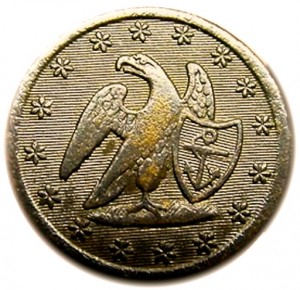
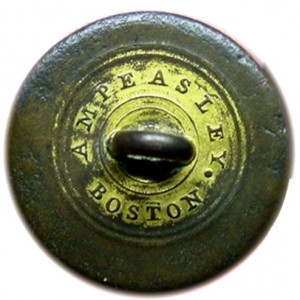
1810-30’s United States Navy Button
Color: A Brass Brown With Gold Highlights.
Metal: Flat, 1-Piece, Raised Design, Gilt Brass.
Size: 23 mm. Coat size
Albert’s Number: NA 66-B: RV 12-15
Variation: Small Spade Shaped Shield / Small Fouled Anchor / Straight Stock / Slightly Barbed Crown / 16 Six-Pointed Asterisk Type Stars.
Present Condition: An Excavated Example, Exceptional Planchet Casting, Strong High-Relief Pattern Remains.
Isabela’s Notes: This is another die variant made by A.M. Peasley of Boston. This one has a different style star depicted. The button’s pattern depicts an eagle standing on a mound while facing right with raised up-raised wings. Partially covering over the eagle’s left wing is a Small Wide Spade Shaped Shield. Depicted on the shield is a Small Fouled Anchor with a Straight Stock and a Slightly Barbed Crown. The rope in this variant comes off the anchor’s top ring on the right hand-side, and then goes over the stock, under the shaft & left fluke, and ends slightly below the crown. Circling around the eagle is 16 Six-Pointed Asterisk Type Stars. The high relief pattern is set on a lined field with a round picture frame raised border edge.
Reverse Button Analysis: This is a one-piece button with a loop shank. The shank is original, straight, and intact. A.M. PEASLEY/BOSTON rm
The J. Baldwin Collection.~
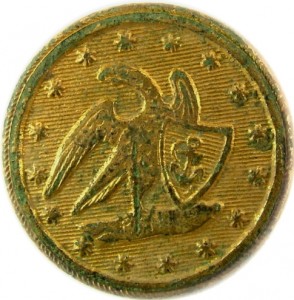
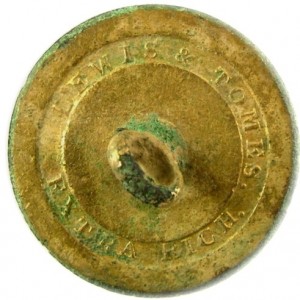
1820-30’s United States Navy Button
Color: A Light Gold With Sea foam Green.
Metal: Flat, 1-Piece, Raised Design, Gilded Brass.
Size: 23 mm. Coat Size
Albert’s Number: NA 67-A: RV 15
Variation: Eagle Facing Right / Slanted Spade Shaped Shield / Small Fouled Anchor / Straight Stock / Barbed Crown / Thin Rope Edge.
Present Condition: An Excavated Example, Strong Planchet Casting, Strong High Relief Pattern Remains.
Isabela’s Notes: This new style button is very similar to the previous patterns in the series, but adds a thin decorative rope to the button’s edge. This button’s pattern depicts a standing Eagle Facing Right, with raised up-right wings. Partially covering over the eagle’s left wing is a Slanted Spade Shaped Shield. Depicted on the shield is a Small Fouled Anchor with a Straight Stock and a Barbed Crown. The rope comes off the anchor’s top ring on the right hand-side, and goes over the stock, under the shaft and fluke, and dangles under the crown. Circling around the eagle is 16 Six-Pointed Asterisk Type Stars. The high relief pattern is set on a lined field with a flat round picture frame border and a Thin Rope Edge Trim. The back mark dates this specimen dates from 1820, but the pattern might have come around earlier. (Lewis Tomes 01).
Reverse Button Analysis: This is a flat one-piece button with a soldered on loop shank. The shank is original, straight, and intact. LEWIS & TOMES EXTRA RICH rm within a channel.
Picture Courteous of Harry Ridgeway / Museum Collection.~
Excavated in Keedyville, Maryland.~
Robert’s Notes: Lewis & Tomes was an English button maker who operated a partnership in America.
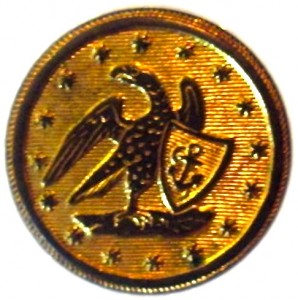

1820-30’s United States Navy Button
Color: A Golden Brass Yellow.
Metal: Flat, 1-Piece, Raised Design, Gilded Brass.
Size: 23 mm. Coat Size
Albert’s Number: NA 67-A: RV 15
Variation: 16 Six-Pointed Stars/Rope Edge.
Present Condition: A Non Excavated Specimen, Exceptional Planchet Casting, Exceptional High Relief Patten Remains.
Isabela’s Notes: This button is another specimen manufactured by Lewis & Tomes, but with a latter backmark. This button’s pattern depicts a standing eagle facing right, with raised up-right wings. Under the left wing is a Spade Shaped Shield, with a Small Fouled Anchor depicted on a lined field. The rope comes off the anchor’s top ring on the right hand-side, and goes over the stock, under the shaft and fluke, and dangles under the crown. There is 16 Six-Pointed Asterisk Type Stars encircling the eagle on the outside edge. The high relief pattern is set on a lined field with a Thin Raised Border and Outside Rope Edge.
Reverse Button Analysis: This is a one-piece button with a loop shank. The shank is original, straight, and intact. LEWIS & TOMES EXTRA RICH 2 within a two ring rm.
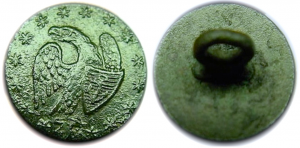
1820-30’s United States Navy Button
Color: An Olive Grey.
Metal: Flat, 1-Piece, Raised Design, Pewter.
Size: 16mm. Cuff Size
Albert’s Number: NA 72-Av: RV 7
Variation: Slanted Spade Shaped Shield / Small Foul Anchor / 16 Six-Pointed Asterisk Type Stars.
Present Condition: An Excavated Example, Strong Planchet Casting, Strong High Relief Pattern Remains.
Isabela’s Notes: The button’s pattern depicts a standing Eagle Facing Right, with raised up-raised wings. Under the left wing is a Slanted Spade Shaped Shield, with a Small Fouled Anchor on a lined field. The rope comes off the anchor’s top ring on the right hand-side, and goes around the stock, under and over the shaft, then over the right fluke off the side. There are 16 Six-Pointed Asterisk Type Stars encircling the eagle on the outside edge. The high relief pattern is set on a plain flat field with a plain edge..
Reverse Button Analysis: This is a flat one-piece button with a soldered on loop shank. The shank is original, straight, and intact.
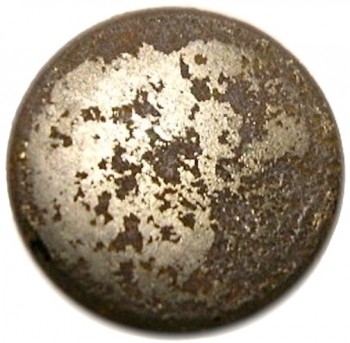

1820-30’s United States Navy Style Reverse Button
Color: An Olive Grey.
Metal: Flat, 1-Piece, Raised Design, Silvered Copper.
Size: 19 mm. Coat Size
Albert’s Number: NA 75-B RV 05
Variation: Slanted Spade Shape Shield / Small Spade Shape Shield / Square Notch Border.
Present Condition: An Excavated Example, Good Planchet Casting, Strong High Relief Pattern Remains.
Isabela’s Notes: This button is an unusual specimen that has the device on the back of the button. This style was very popular during the 1820’s with political buttons as well. There are two known die variants, one that is a little bigger with 20 six pointed stars on the border, and a smaller example with square notches. What the style pattern tells me, is that it is the same style as a Jacksonian Political Reverse Style Button. This button could have been worn on Breeches, or just on a shirt’s cuff. The button’s pattern depicts a standing Eagle Facing Right, with a Slanted Spade Shaped Shield under it’s left wing. Within the shield is a raised anchor within on a lined field. The anchors rope comes off the anchor’s top ring on the right hand-side, and goes under the stock, shaft, and left fluke, then hangs below the crown. The high relief pattern is on a lined field with a decorative Square Notch Border.
Reverse Button Analysis: This is a one-piece button with a loop shank. The shank is original, straight, and intact.
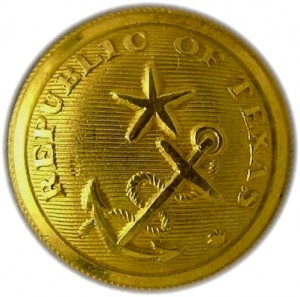
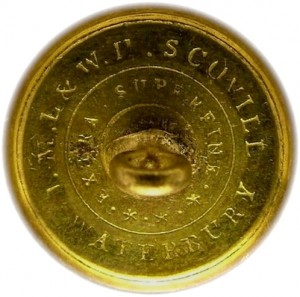
1820’s Republic of Texas Navy
Color: Dripping Gold!
Metal: Low Convex, 2-Piece, Raised Design, Gilt Brass.
Size: 21 mm. Coat Size
Albert’s Number: TX 1: RV 100
Tice’s Number: TX 219-A.1
Variation: Five-Pointed Lone Star / Large Slanted Raised Anchor / Republic of Texas.
Present Condition: A Non Excavated Example, Exceptional Planchet Casting, Exceptional High Relief Pattern Remains.
Isabela’s Notes: The Republic of Texas originally tried to form it’s own country, so naturally they formed their own Navy to defend Galveston Bay against the Mexicans. The button’s pattern depicts a Five-Point Lone Star above a Large Slanted Raised Anchor. The rope comes off the anchor’s top ring on the left hand-side, and goes under the stock, shaft 3x, and then under the right fluke where it hangs below. Republic of Texas is in large Roman Font letters arced in the top legend. The high relief pattern is set on a lined field with an Angled Thin Flat Border and Pipe Rope Edging.
Reverse Button Analysis: This is a two-piece flat construction with a soldered on loop shank. The shank is original, straight, and intact. J.M.L.& W.H. / SCOVILLS / dm ring WATERBURY. EXTRA. SUPERFINE *.*.* inner dm ring
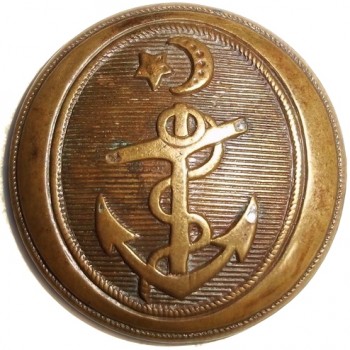
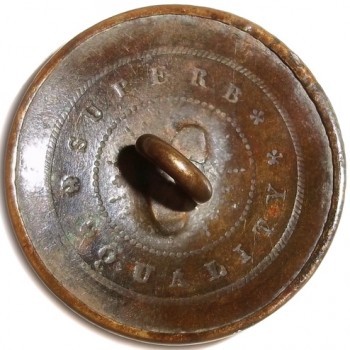
1820’s OTTOMAN / TURKISH NAVY
Color: Soft Brown Leather.
Metal: Low Convex, 2-Piece, Raised Design, Gilt Brass.
Size: 23 mm. Coat Size
Albert’s Number: Unlisted Prototype – RV 300
Tice’s Number: Unlisted Prototype
Variation: Five-Pointed Lone Star / Large Raised Anchor / 8 Dotted Crescent Moon / Republic of Texas.
Present Condition: A Non Excavated Specimen, Exceptional Planchet Casting, Exceptional High Relief Pattern Remains.
Isabela’s Notes: The button’s pattern depicts a Five-Pointed Star with a Small Stipple Within Each Point. To the left of the star is a Crescent Moon with 8 Small Arcing Stipples. The stipples combined from the star and moon equal 13. The star and moon is depicted above a Large Raised Navy Anchor. The rope comes off the anchor’s top ring on the left hand-side, and goes under the stock, then shaft 3x, and then under the right fluke where it hangs straight below. The high relief pattern is set on a evenly thin lined field with a Center-Wide Flat Border with Thin Pipe Rope Edging on each side.
Reverse Button Analysis: This is a two-piece flat construction with a soldered on loop shank. The shank is original, straight, and intact. ** SUPERB ** QUALITY WITHIN 2 DOTTED RINGS.
The RJ.Silverstein Collection.

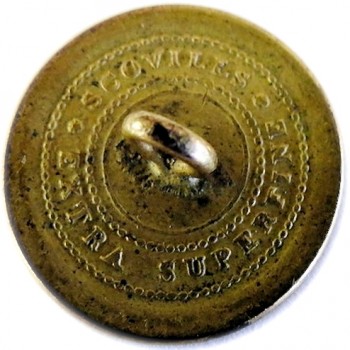
1837 Republic of Texas Navy
Color: A Coppery Golden Brown.
Metal: Flat, Oval, 1-Piece, Raised Design, Gilt Brass.
Size: 23mm. Coat Size
Albert’s Number: TX 3 RV 100
Tice’s Number: TX222 A.1
Variation: Large Five Point Star Star / Upright Fouled Anchor / Barbed Crown / Esperensia / Oval Picture Frame.
Present Condition: A Non Excavated Example, Strong Planchet Casting, Strong High Relief Pattern Remains.
Robert’s Comments: This button was produced by Scovills in 1837. They made both a coat and matching cuff. The button’s pattern depicts a Large Five Point Star above an Upright Fouled Anchor with a Barbed Crown. The anchor shows the top ring folded over with a rope coming off the left hand side. The rope goes under the stock, shaft, and right fluke, then ends dangling below the crown. Above the star is the motto, “ESPERENSIA” in large capital letters. The high relief pattern is set on a lined field within an Oval Picture Frame with Pipe Rope Edging. This is a very popular button for early southern collectors. Reproductions were cast in silver during the 1930’s.
Reverse Button Analysis: This is a one-piece button with a soldered on loop shank. The shank is original, straight, and intact. * SCOVILLS * / EXTRA SUPERFINE rm within a 2 ring rope pattern rm.

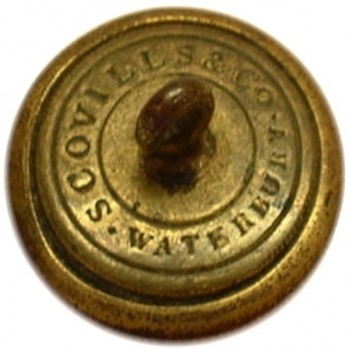
1840 Republic of Texas Navy (2nd Fleet)
Color: Brass Yellow.
Metal: Convex, 2-Piece, Raised Design, Gilt Brass.
Size: 23 mm. Coat Size
Albert’s Number: TX 4: RV 150
Tice’s Number: TX 224
Variation: Five-Pointed Lone Star / Vertical Fouled Anchor / Republic of Texas.
Present Condition: A Non Excavated Example, Exceptional Planchet Casting, An Exceptional High Relief Pattern Remains.
Isabela’s Notes: After keeping the Mexicans at bay for 2 years, the 1st Texas Navy came to an untimely end for various reasons. First, two of their ships, the Brutus and Invincible ran aground on a sand bar in Galveston Bay. The Independence was taken by Mexico at Velasco, and the Liberty was sold to cover the costs of the repairs. Texas began rebuilding their Navy in 1838, to deter Mexico from trying to take back territory from the 1836 war of Texas Independence. The new fleet was going to be comprised of 3 schooners, 2 brigs, a steam packet, and a supply ship. As provisions were ordered for the new fleet, Scovills sent over an attractive button in 1840 which had a unique stipple & mat background. The button’s pattern depicts a Five-Point Lone Star surmounting a Vertical Fouled Anchor. The anchor has an Upright Top Ring and a Straight Stock. The Crown has a Slight Raised Barb with two large fluke ends. There is a small banner ribbon on both the left and right hand-side of the anchor. On the right hand-side the ribbon is inscribed, “TEXAS” in raised Roman font capital letters. On the left hand-side the banner ribbon has the military designation, “NAVY” which is also in raised Roman font capital letters. Surrounding the inner pattern is an Oak Wreath on the right side, and a Laurel Wreath on the left. There is a narrow raised angled Border with Pipe Rope Edge on the outside.
Reverse Button Analysis: This is a Convex two-piece construction with a soldered on loop shank. The shank is original, straight, and intact. . SCOVILLS & Co. / Waterbury dm.


1820 to 1830’s Un-Adopted Style Navy Button
Color: Tarnished Brass.
Metal: 1-Piece, Flat, Raised Design, Gilt Brass.
Size: 23.28mm. Coat Size
Albert’s Number: Unlisted Die Variant
Variation: Eagle Facing Right / Medium Vertical Shield / Medium Size Fouled Anchor / 17 Six Point Asterisk Type Stars.
Present Condition: A Non Excavated Specimen, Exceptional Planchet Casting, Exceptional High Relief Pattern Remains.
Robert’s Notes: This unlisted button was most likely made to market by English Manufacturers for officers serving in the U.S. Navy. This pattern can go as far back as 1810,with a highbred of Albert’s NA 20 series, but most likely wasn’t used until late 20’s and 30’s. In the late 1820’s and 1830’s this pattern with the center-wide borders was used both for Republic of Texas Navy and also various State Militia Officers buttons. This high end Gilt button’s pattern depicts an Eagle Facing Right while standing on a cable. There is a medium size Vertical Oval Shield over the eagle’s left wing. Within the shield there is an Upright Fouled Anchor with a Straight Stock on a stippled field. The cable comes off the Anchors Upright Top Ring on the R-H-S and goes under the stock, shaft and left fluke. There is 17 Asterisk Type Stars encircling the eagle. There is an Oval Center-Wide Picture Frame Border with a Pipe Rope Edge. The pattern is set on a Flat Evenly Lined Field.
Reverse Button Analysis: This is a flat one-piece button with a copper loop shank. The shank is original, straight, and intact. Gilt / Wreath / London / Wreath within a channel.
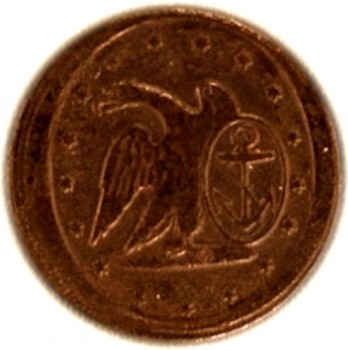
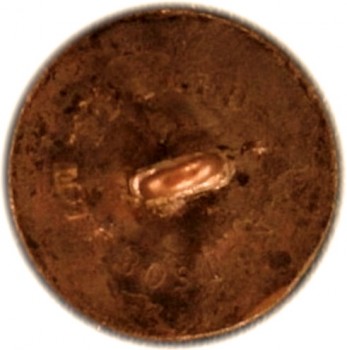
1820 to 1830’s U.S. Navy Button
Color: Tarnished Brown.
Metal: 1-Piece, Raised Design, Gilt Brass.
Size: 23mm. Coat Size
Albert’s Number: Unlisted Variant / Appears to fall between NA 25-31: RV ?
Variation: Eagle Facing Right / Medium Vertical Shield / Medium Size Fouled Anchor / 17 Six Point Asterisk Type Stars.
Present Condition: A Dug Example, Strong Planchet Casting, Good High Relief Pattern Remains.
Isabela’s Notes: This is the second example of this pattern that was made by a Boston Manufacturer. This Navy button’s pattern is not listed in Albert’s known Navy Button patterns. This unlisted variant must have been used for a brief time since 2 different manufacturers produced the pattern. I think the unusual pattern falls somewhere between Albert’s missing patterns NA 25-31. This high end button’s pattern depicts an Eagle Facing Right while standing on a cable. There is a medium size Vertical Oval Shield covering over the eagles left wing. Within the shield there is an Upright Fouled Anchor with a Straight Stock on a stippled field. The cable comes off the Anchors Upright Top Ring and goes under the stock, shaft and left fluke. There is 17 Asterisk Type Stars encircling the eagle. There is an Oval Center-Wide Picture frame Border with a Pipe Rope Edge. The pattern is set on a Flat Evenly Lined Field.
Reverse Button Analysis: This is a one-piece button with a loop shank. This is a replaced shank, but is straight, and intact. ????? BOSTON rm.


1830’s to 1850’s US Federal Navy Officer’s Button
Color: Gilt With Brass Undertones.
Metal: Flat, 1-Piece, Raised Design, Gilt Brass.
Size: 22.96mm. Coat Size
Albert’s Number: NA 81-A.1: RV 25
Variation: 16 Evenly Spaced Six-Pointed Stars / Plain Wide Oval Border / Evenly Lined Field
Present Condition: A Non Excavated Specimen, Exceptional Planchet Casting, Strong High Relief Pattern Remains.
Isabela’s Notes: There appears to be 3 coat and cuff variants of an eagle standing on the flukes of an upright anchor. The original and rarest has a “United States / Navy” backmark. This button was made by an English manufacturer for Naval Officers in the 1830’s. The button’s pattern depicts an Eagle Standing on the Flukes of an Upright Anchor facing left. There is 16 Uniformly Spaced Six-Pointed Stars encircling the eagle around the inside border. This is followed by a Plain Wide Oval Border with Outside Pipe Rope Edging. This high relief pattern is set on an Evenly Lined Field.
Reverse Button Analysis: This is a flat one-piece button with a loop shank. The shank is straight and intact. * TREBLE.GILT*STANDARD R. COLOUR *
The RJ. Silverstein Collection.~
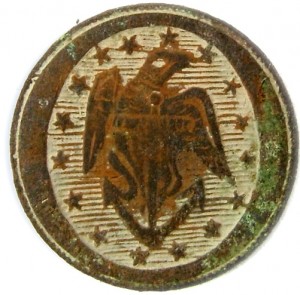

1830’s to 1850’s US Federal Navy Officer’s Button
Color: White Wash Rusty Red.
Metal: Flat, 1-Piece, Raised Design, Gilt Brass.
Size: 16mm. Cuff Size
Albert’s Number: NA 81-Bv: RV 05
Variation: 16 Irregularly Spaced Five-Pointed Stars / Plain Wide Oval Border /Irregular Lined Field
Present Condition: An Excavated Specimen, Good Planchet Casting, Good High Relief Pattern Remains.
Isabela’s Notes: This button was made by an English manufacturer for Naval Officers in the 1830’s (Gilt 02). The button’s pattern depicts an eagle standing on the flukes of an upright anchor facing left. There is 16 Irregularly Spaced Five-Pointed Stars encircling the eagle around the inside border. This is followed by a Plain Wide Oval Border with an Outside Pipe Rope Edging. This high relief pattern is set on an Irregular Lined Field. These earlier specimens do not use an “inside” rope border for the pattern. There is also another cuff variation of this pattern with 14 stars.
Reverse Button Analysis: This is a flat one-piece button with a loop shank. The shank is broken. A Circle of 8 six-pointed stars with alternating dots GILT.
Picture courteous of Harry Ridgeway.~
Excavated in Harper’s Ferry West Virginia.~
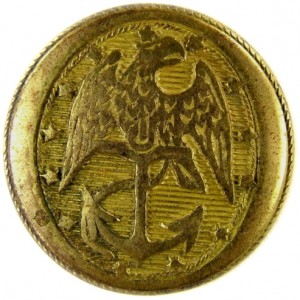

1830’s to 1850’s US Federal Navy Officer’s Button
Color: Brass Yellow.
Metal: Flat, 1-Piece, Raised Design, Gilt Brass.
Size: 23mm. Coat Size
Albert’s Number: NA 86-A.2: RV 10
Variation: Rope Passes Left to Right / 13 Raised Five-Pointed Stars / Thin Rope Edge Border.
Present Condition: A Non Excavated Specimen, Exceptional Planchet Casting, Strong High Relief Pattern Remains.
Isabela’s Notes: This popular Navy Officer’s button was made by at least nine different manufactures, and has two known die variants. One with the rope passing left to right, and the other with the rope passing right to left. This style pattern was known to be manufactured during the late 1820’s, but was prevalent in use from the 1830’s to the 50’s. The button’s pattern depicts an Eagle at Rest Perched on the stock of an Upright Fouled Anchor while facing left. The anchor’s Rope Passes from Left to Right under the stock, and then hangs under the right fluke almost to the barb on the crown. In this variant, the anchor is a bit more pronounced, and shows Thicker Flukes. There is 13 Raised Five-Pointed Stars encircling the eagle around the inside border. This is followed by a Thin Rope Edge Border, which outlines a center-wide plain oval border with an outside pipe rope edge. The high relief inside pattern is set on a lined field.
Reverse Button Analysis: This is a flat one-piece button with a loop shank. The shank is original, straight, and intact. rm * L & KENDRICK */EXTRA RICH inside rope ring rm.
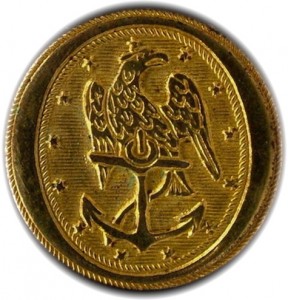

1830’s to 1850’s US Federal Navy Officer’s Button
Color: Brass Yellow.
Metal: Flat, 1-Piece, Raised Design, Gilt Brass.
Size: 22.6mm. Coat Size
Albert’s Number: NA 86-A.3: RV 10
Variation: Rope Passes Left to Right / 13 Raised Five-Pointed Stars / Thin Rope Edge Border.
Present Condition: A Non Excavated Specimen, Exceptional Planchet Casting, Exceptional High Relief Pattern Remains.
Isabela’s Notes: This die variant was made by Lewis & Tomes for Naval Officers in the late 1820’s or 1830’s (Lewis Tomes 07). The button’s pattern depicts an Eagle at Rest perched on the stock of an upright fouled Anchor while facing left. The anchor’s Rope Passes from Left to Right under the stock & shaft, and then a small piece emerges from under the right fluke. In this variant, the Anchor is Slimmer & Bowed with Narrow Pointed Flukes. There is 13 Raised Five-Pointed Stars that encircle the eagle. This is followed by a Thin Pipe-Rope Edge Border. This is the framework for an oval center-wide picture frame with an outside pipe rope edge. The high relief inside pattern is set on an Evenly Thin Lined Field.
Reverse Button Analysis: This is a flat one-piece button with a loop shank. The shank is original, straight, and intact. LEWIS & TOMES/ EXTRA RICH rm 2 ring channel.
This style pattern was known to manufactured in the late 1820’s, but was prevalent from the 1830’s to the 50’s.
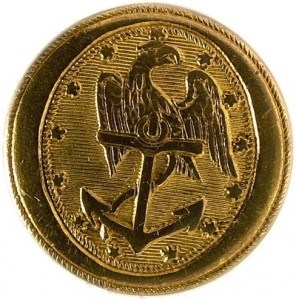
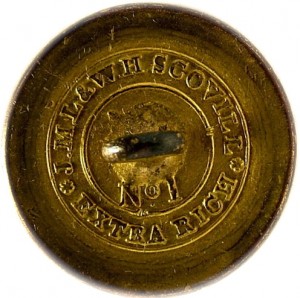
1830’s to 1850’s US Federal Navy Officer’s Button
Color: Rich Gold.
Metal: Flat, 1-Piece, Raised Design, Gilt Brass.
Size: 23mm. Coat Size
Albert’s Number: NA 86-A-Unlisted Backmark Variation: RV 15
Variation: 13 Five-Pointed Stars / Rope Passes Left to Right
Present Condition: A Non Excavated Specimen, Exceptional Planchet Casting, Strong High Relief Pattern Remains.
Isabela’s Notes: This die variant was made by J.M.L & W.H Scovill (Scovill09) from 1827 to 1840. The button’s pattern depicts an
Eagle Perched on a Stock of an upright anchor while facing left. The anchor’s rope passes from left to right under the stock, shaft and right hand-side fluke. The small piece of the rope ends dangles under the right fluke. The anchor is a bit more pronounced with a Nice Thick Barbed Crown with wide flukes. There is 13 Raised Five-Pointed Stars encircling the eagle. This is followed by an inner circling pipe rope border. The pattern is depicted in a center wide oval picture frame with outside pipe rope edging. The whole inside pattern is also set on an evenly lined field.
Reverse Button Analysis: This is a flat one-piece button with a loop shank. The shank is original, straight, and intact. rm *J.M L &W.H SCOVILL */EXTRA RICH/No1 set in a rm 2 ring channel.
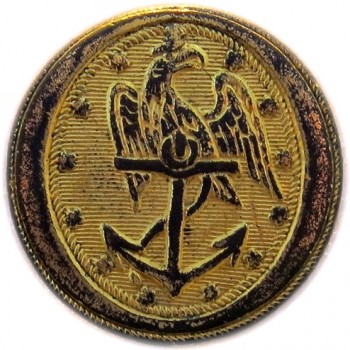
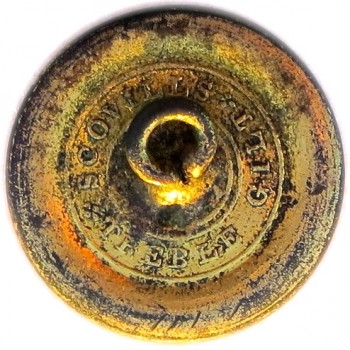
1830’s to 1850’s US Federal Navy Officer’s Button
Color: Rich Gold.
Metal: Flat, 1-Piece, Raised Design, Gilt Brass.
Size: 22.47mm. Coat Size
Albert’s Number: NA 86-A-Unlisted Backmark Variation: RV 25
Variation: 13 Five-Pointed Stars / Rope Passes Left to Right
Present Condition: An Excavated Specimen, Exceptional Planchet Casting, Strong High Relief Pattern Remains.
Isabela’s Notes: This is another die variant made by Scovill in the early years with a much rarer backmark to obtain. The button’s pattern depicts an Eagle Perched on a Stock of an upright anchor while facing left. The anchor’s rope passes from left to right under the stock, shaft and right hand-side fluke. The small piece of the rope ends dangles under the right fluke. The anchor is a bit more pronounced with a Nice Thick Barbed Crown with wide flukes. There is 13 Raised Five-Pointed Stars encircling the eagle. This is followed by an inner circling pipe rope border. The pattern is depicted in a center wide oval picture frame with an outside pipe rope edging. The whole inside pattern is set on an evenly lined field.
Reverse Button Analysis: This is a flat one-piece button with a loop shank. The shank is original, straight, and intact. rm SCOVILL */TEEBLR GILT/ set in a rm 2 ring channel.
The RJ. Silverstein Collection.~


1830’s to 1850’s US Federal Navy Officer’s Button
Color: Rich Gold.
Metal: Flat, 1-Piece, Raised Design, Gilt Brass.
Size: 15.20mm. Cuff Size
Albert’s Number: NA 86-A-Unlisted Backmark Variation: RV 25
Variation: 13 Five-Pointed Stars / Rope Passes Left to Right
Present Condition: A Non Excavated Specimen, Exceptional Planchet Casting, Strong High Relief Pattern.
Isabela’s Notes: This small cuff button’s pattern depicts a more crude style Eagle Perched on the Stock of an upright anchor while facing left. The anchor’s rope passes from left to right under shaft and the right hand-side fluke. The anchor is a bit more pronounced with a Nice Thick Barbed Crown with Wide Pointed Flukes. There is 13 Raised Five-Pointed Stars encircling the eagle. This is followed by an inner circling pipe rope border. There is a center wide oval picture frame with outside pipe rope edging. The whole inside pattern is set on an evenly lined field.
Reverse Button Analysis: This is a flat one-piece button with a loop shank. The shank is original, straight, and intact. Impressed WARRANTED./RICH ORANGE.
The RJ. Silverstein Collection.~
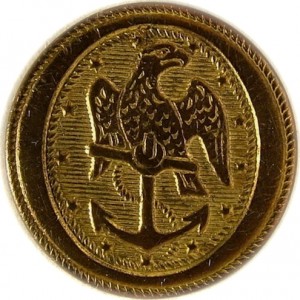
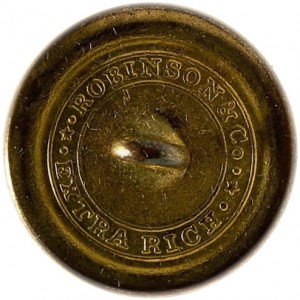
1830’s to 1850’s US Federal Navy Officer’s Button
Color: Aged Gold.
Metal: Flat, 1-Piece, Raised Design, Gilt Brass.
Size: 16mm. Cuff Size
Albert’s Number: NA 86-Bv: RV 03
Variation: 13 Five-Pointed Stars / Rope Passes Right to Left
Present Condition: A Non Excavated Specimen, Exceptional Planchet Casting, Exceptional High Relief Pattern Remains.
Isabela’s Notes: This is the only backmark Richard Robinson used for this alternate die variant where the rope passes right to left. Robinson did manufacture the original die variant (Pattern A) with three known backmarks in the 1820-30’s. This particular pattern was made by Richard Robinson (Robinson R08) in the 1820’s. This alternate pattern is extremely similar to “A”, except for the eagle’s feathering, and the rope passes right to left. The button’s pattern depicts an eagle at rest, that is perched on an upright anchor’s slanted stock. The Eagle is Facing Left in this variant. The anchor’s rope comes from under the right hand side of the stock and Passes Right to Left under the stock, shaft and then the left fluke. The Rope Almost Touches the inner rope border under the crown. There is 13 Five-Pointed Stars encircling the eagle and stars around the inside border. This is followed by a thin pipe rope edge, which leads into a plain wide oval border with it’s own lowered outside pipe rope edge. The high relief inside pattern is set on an evenly lined field.
Reverse Button Analysis: This is a flat one-piece button with a loop shank. The shank is original, straight, and intact. rm * . ROBINSON & Co.*/ EXTRA RICH. rm
This style pattern was known to manufactured in the late 1820’s, but was prevalent from the 1830’s to the 50’s.
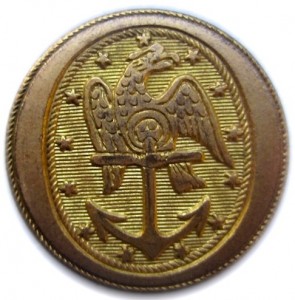
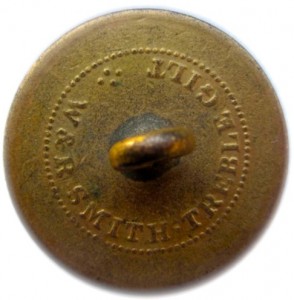
1830’s Navy Button
Color: A Golden Coppery Brown
Metal: High Relief, 1-Piece Gilded Brass.
Size: 22.46mm. Coat Size
Albert’s Number: NA 87: Unlisted B/M RV 30
Variation: Barbed Anchor / 13 Five-Pointed Star / Pipe Rope Edge.
Present Condition: A Non Excavated Specimen, Exceptional Planchet Casting, Exceptional High Relief Pattern Remains.
Isabela’s Notes: This one-piece button was part of the new transitional style (from an Eagle standing on the Flukes of an upright Anchor, to an Eagle resting upon the Stock of an upright Anchor) adapted by the U.S. Navy. This new style pattern was used throughout the 1830’s and 40’s. Some backmark research indicates this button was produced in the very early 1830’s. We also know that W.H. Smith operated from the 1830’s to around 1858. (W.H. Smith was an outfitter, and the buttons were manufactured by Scovill). The button depicts a Perched Eagle on an Barbed Anchor facing left. There is 13 Five-Pointed Stars encircling the eagle around the inside border. This is followed by a thin pipe rope edge, which leads into a plain center wide oval border with an outside Pipe Rope Edge. The high relief inside pattern is set on an evenly lined field.
Reverse Button Analysis: A one-piece button with a loop shank. The shank is original, straight, and intact. W & H SMITH. TREBLE GILT four dot
The RJ Silverstein Collection.~
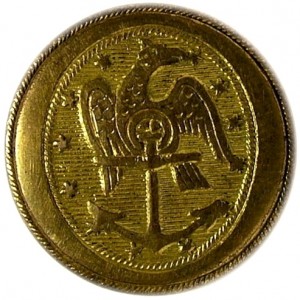
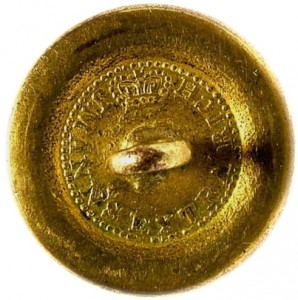
1820’s to 1850’s US Navy Officer’s Button
Color: Two Tone Gold.
Metal: Flat, 1-Piece, Raised Design, Gilt Brass.
Size: 22.7mm. Coat Size
Albert’s Number: NA 87-A.1: RV 10
Variation: 13 Five-Pointed Stars / Rope Passes Right to Left
Present Condition: A Non Excavated Specimen, Exceptional Planchet Casting, Exceptional High Relief Pattern Remains.
Isabela’s Notes: This button was made by an English manufacturer J. Manns (Mann02) during the 1820’s or 1830’s. The button’s pattern depicts the same style and pattern as NA 86-A, but there is No Rope coming off the anchor’s top ring. The button’s pattern depicts a Perched Eagle on a vertical anchor’s stock while facing left. As with NA 86-A the Anchor is Slimmer with Two Heavier Flukes. There is 13 Five-Pointed Stars encircling the eagle; and the eagle’s head and beak touch the top stars. This inside pattern is followed by a thin pipe-rope edge and a center-wide oval border that has a lower pipe rope circling edge. The whole inside pattern is set on an evenly lined field.
Reverse Button Analysis: This is a flat one-piece button with a loop shank. The shank is original, straight, and intact. rm J.MANN’S EXTRA RICH with a surmounting Crown surrounded by dots. outer circle of rm dots encircling marker.
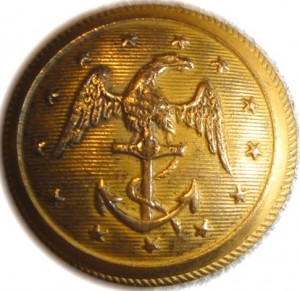
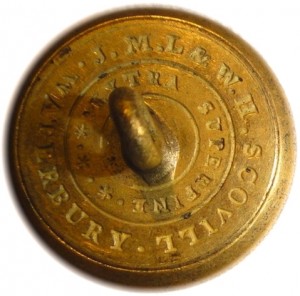
1835-50 United States Navy Button
Color: Tarnished Brass Yellow.
Metal: 2-Piece, Low-Convex, Raised Design, Gilded Brass.
Size: 22mm. Coat Size
Albert’s Number: NA 106: RV 5
Tice’s Number: NA212A.13
Variation: 13 Five-Pointed Stars.
Present Condition: A Non Excavated Specimen, Exceptional Planchet Casting, Exceptional High Relief Pattern Remains.
Isabela’s Notes: There are quite a few different manufacturers die variants for this popular pattern. The pattern was manufactured for 15 years, and several companies had more then one back mark. The button’s pattern depicts an eagle standing on the stock of a raised anchor. The Eagle is Facing Left with Spread Wings. The Anchor’s rope dangles off the left hand-side of the stock and goes under and over the shaft, and then hangs under the left fluke. There is 13 Five-Pointed Stars that encircle the eagle. The high relief pattern is set on an evenly lined field with an inner raised border and an outer Beveled Rope Edge.
Reverse Button Analysis: This is a two-piece button with a loop shank. The shank is original, straight, and intact.

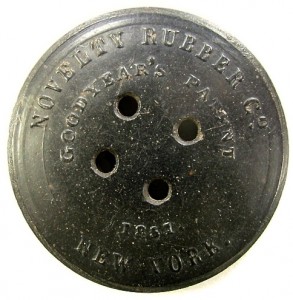
1849-51 United States Navy
Color: A Faded Black.
Rubber: 1-Piece, Slightly Concave, Raised Design, Hard Rubber.
Size: 35mm. Coat Size
Albert’s Number: NA 137-A.2: RV 3
Tice’s Number: NA 244C.1
Variation: Horizontal Anchor with A Slanted Stock / Periods Between Initials / Raised Rim Sew Holes.
Present Condition: A Non Excavated Example, Strong Plastic Casting, Strong High Relief Pattern Remains.
Isabela’s Notes: This button was intended for the Navy’s enlisted men. There are three known die variants. One with periods after the initials, and without periods; and one with a vertical anchor with periods. The size and slant on the horizontal anchor specimens also differ. Lastly, there are some specimens in all three variants without raised rims around the sew holes. The button’s pattern depicts the initials, “U.S.N.” arced above with the periods between the initials. Underneath, there are Three Raised Five-Pointed Stars stretching from the center to the raised border. There is a Horizontal Raised Anchor with a slanted stock on the bottom. The rope comes off the anchor’s top ring on the left, and then goes under the stock, under and over the shaft, then under the fluke, and finally dangles below the crown. There are Four Large Raised Rim Sew Holes that surround the center star. The high relief pattern is set on a stippled field with a large round border. Collector’s seek double patent date backmarks.
Reverse Button Analysis: This is a one-piece button with four holes. NOVELTY RUBBER Co. NEW YORK. / GOODYEAR’S PATENT 1851.
Picture Courteous of Harry Ridgeway.~
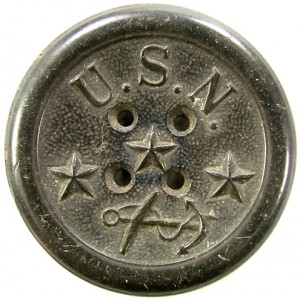
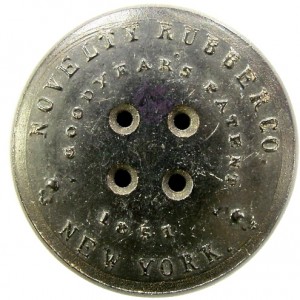
1849-51 United States Navy
Color: A Dusty Dirt Black.
Rubber: 1-Piece, Slightly Concave, Raised Design, Hard Rubber.
Size: 35mm. Coat Size
Albert’s Number: NA 137-A.2: RV 3
Tice’s Number: NA 244-B.1
Variation: Horizontal Anchor with A Slanted Stock / Periods Between Initials / Beveled Rim Sew Holes Remains.
Present Condition: An Excavated Example, Strong Plastic Casting, Strong High Relief Pattern.
Isabela’s Notes: This button was intended for the Navy’s enlisted men. There are three known die variants. One with periods after the initials, and without periods; and one with a vertical anchor with periods. The size and slant on the horizontal anchor specimens also differ. Lastly, there are some specimens in all three variants without raised rims around the sew holes. The button’s pattern depicts the initials, “U.S.N.” arced above with the periods between the initials. Underneath, there are Three Beveled Five-Pointed Stars stretching from the center to the raised border. There is a Horizontal Raised Anchor with a slanted stock on the bottom. The rope comes off the anchor’s top ring on the left, and then goes under the stock, under and over the shaft, then under the fluke, and finally dangles below the crown. There are Four Large Sew Holes with Without Raised Rims surrounding the center star. The high relief pattern is set on a stippled field with a large round border. Collector’s seek double patent date backmarks.
Reverse Button Analysis: This is a one-piece button with four holes. NOVELTY RUBBER Co. NEW YORK. / GOODYEAR’S PATENT 1851.
Picture Courteous of Harry Ridgeway.~
1851-65 United States Navy, Enlisted Men
Color: A Dark Black.
Rubber: 1-Piece, Slightly Concave, Raised Design, Hard Rubber.
Size: 31.47mm. Coat Size
Albert’s Number: NA 136-A.2: RV 3
Tice’s Number: NA 241-A.1
Variation: Small Vertical Anchor / Periods Between Initials / Raised Rim Sew Holes.
Present Condition: A Non Excavated Example, Strong Plastic Casting, A Strong High Relief Pattern Remains.
Isabela’s Notes: The navy purchased this new type of hard rubber button for it’s enlisted men between 1851-65. There are three known die variants for this pattern. The button’s pattern depicts the initials, “U.S.N.” arced above with raised stipple-periods between the initials. From the button’s center, there are Three Raised Five-Pointed Stars in a Chevron V formation. In the bottom legend is a Small Vertical Fouled Anchor. The rope comes off the anchor’s upright top ring on the left, and then goes under the stock, then over the shaft, then under the right fluke. The rope end dangles below the right crown. There are four large sew holes with with Small Raised Rims surrounding the Center Star. The high relief pattern is set on a Stippled Field with a large round edge. Some collector’s seek double patent date backmarks because of issue date.
Reverse Button Analysis: This is a one-piece button with four holes. NOVELTY RUBBER Co. / GOODYEAR’S PATENT. / 1851.
The Robert J. Silverstein Collection.


1861-65 Confederate States Navy
Color: A Sandy Grey.
Rubber: 1-Piece, Raised Design, Hard Rubber.
Size: 33mm. Coat Size
Albert’s Number: CS 60-A: RV 75
Tice’s Number: CSN222A.1
Variation: Vertical Fluted Anchor with Slanted Stock / Initials, C N Below
Present Condition: A Non Excavated Example, Strong Plastic Casting, Strong High Relief Pattern Remains.
Isabela’s Notes: This button was intended for enlisted men for the ship CSS Texas. Commander George Terry Sinclair specifically ordered these buttons from an English manufacturer for the Confederate Warship CSS Texas. This powerfull ship was being constructed in the England’s Thomson shipyard, but when the English lost faith in the American cause, it was seized and sold to another foreign power. The buttons were never issued and all were recovered from Sinclair’s estate. The button’s pattern depicts a Large Vertical Fluted Anchor with a slanted stock in the center. Over the anchor is a set of Cross Cannons with a notched out cross in the center. This cross is accompanied by an adjoining sew hole. The Anchor’s Right Fluke is on Top of the Right Cannon. The initials “C N” appear underneath the crown. The whole high relief pattern is set on a stippled filed with a cable border.
Reverse Button Analysis: This is a one-piece button with four holes. COURTNEY & TENNENT./CHARLESTON.S.C./MANTON’S PATENT dm with a swan above.
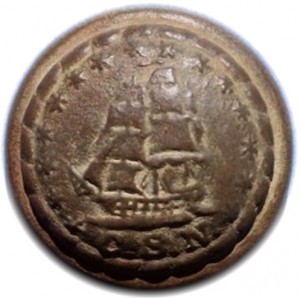
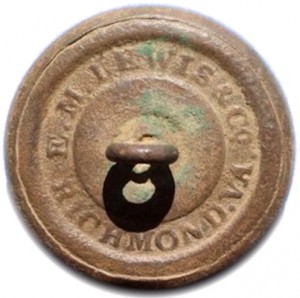
1861-65 Confederate States Navy
Color: Dusty Brown.
Metal: 2-Piece, Convex With Flat Border, Raised Design, Cast White Metal.
Size: 23mm. Coat Size
Albert’s Number: CS 68-A: RV 150
Tice’s Number: CSN270A.1
Variation: Man-of-War /15 Six Pointed Stars.
Present Condition: An Excavated Specimen, Strong Planchet Casting, Strong High Relief Pattern Remains.
Isabela’s Notes: Probably the most attractive button the south ever manufactured. This button’s pattern depicts a Man-of War under sail. The ship is partially surrounded above by an arc of 15 Five Pointed Stars. The initials, “C S N” lie below the ship. Encircling the stars is an outer rope decorative border witch leads to a flat beveled edge. The whole high relief pattern is set on a plain convex field.
Reverse Button Analysis: This is a two-piece button with an integral shank. The shank is original, straight, and intact. E.M.LEWIS & Co/ RICHMOND.VA. rmdc
